January 23
Today was much more of a normal tourist day, as compared to what we’ve been doing on this trip. And that’s not so bad, because, after all, we are tourists.
Picked up at 5:45 by Balloons Over Bagan and bused to the take-off site, where we are served coffee and biscuits. We are broken down into groups of sixteen and given a brief lecture on procedure. Our group of sixteen moves on behind the limp balloon, lying on the ground and receives a safety lecture. Watching the balloon fill with air, first cold and then blasts of hot, is quite exciting. When it is filled, we circle to our positions and climb into the basket.
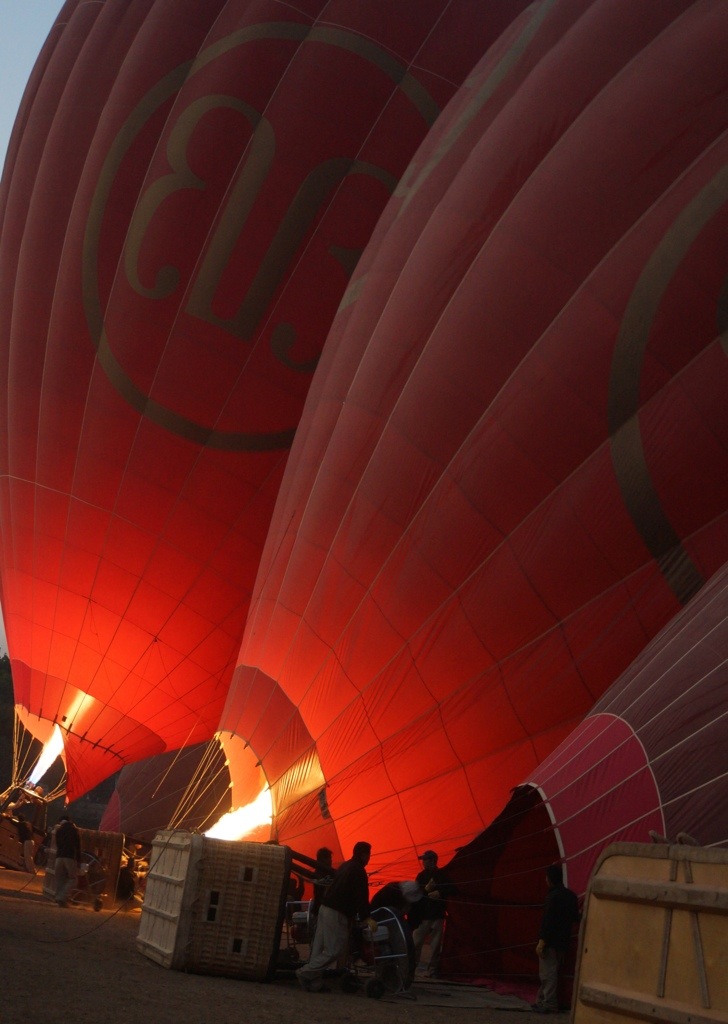
Not long after, we’re aloft and floating towards and over some of Bagan’s 3000 pagodas. Our pilot points out some of the more distinctive structures, but it’s the overall scene which is quite spectacular. Many pictures are taken, including some of the group from a camera tied to the balloon ropes. The pilot can control the height and speed of our, but the wind controls the direction. He jokes that he thinks will blow us over the pagoda area, but that otherwise, we’ll be in the river. After about an hour, we drift down to an easy landing in an open field. We climb out of the basket and are offered champagne and snacks, as well as an opportunity to buy a cd of photos of us taken on the balloon. (I do, of course.) We are then bused back to our hotels–a very,neat, professional and well-thought out operation.
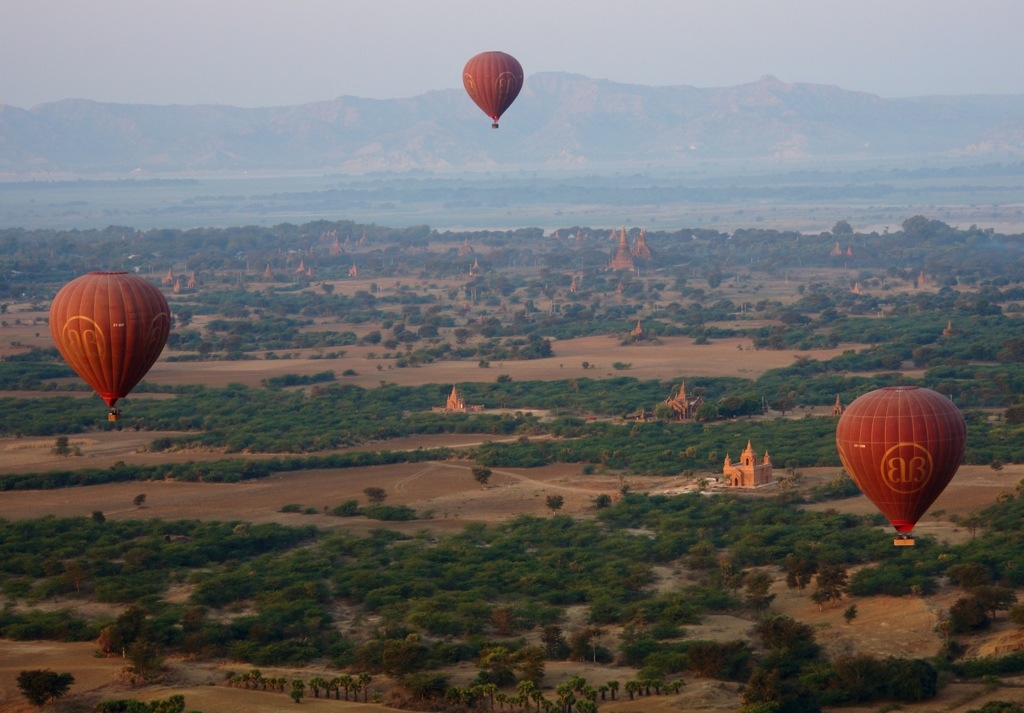
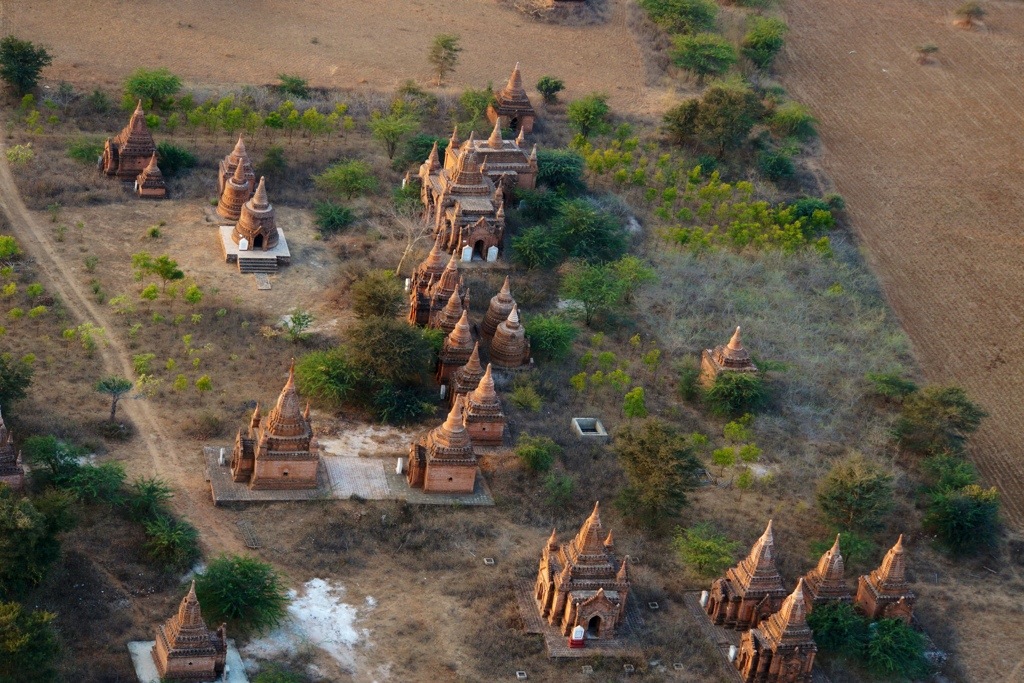
Carol and I are picked up by our guide, Ko Ko, and driver. Ko Ko proves to be an excellent guide, nice manner, good English and an appropriate sense of how much detail we can absorb. He gives us some general background about the six types of buildings/structures–pagodas, temples, monasteries, caves, libraries and ordination centers. And, early on, he describes the four main poses of Buddhas we’ll see–don’t worry, middle way, witnessing and traveling. He talks about Buddha’s first sermon, the five disciples who followed him, his teachings (darma) and those who follow him (sanga).
King Anawradha brought Buddhism to Bagan in 1057, ruled from 1044-1077 and built the first pagoda we see, Shwezigon Pagoda, which has a massive, gold-gilded dome and reputedly houses a tooth, collarbone and frontlet of the Buddha. We spend some time walking around it.
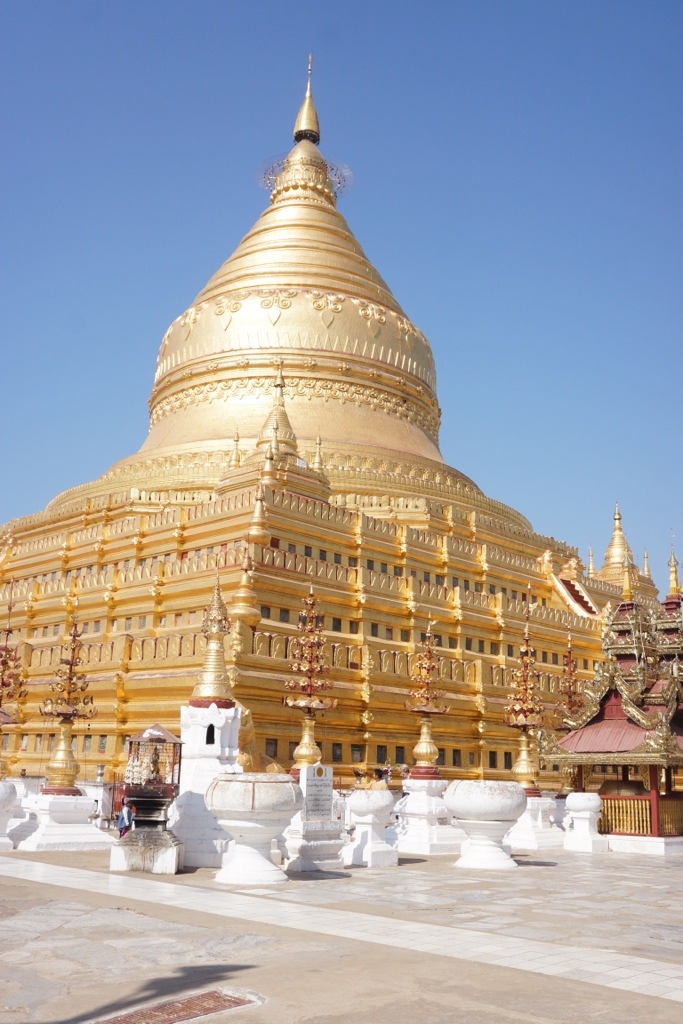

We walk through the Manisithu market, which I would say is an authentic tourist market. It combines fish and vegetables, clearly sold to locals, with goods aimed at the considerable number of tourists who wend through the market. Carol buys four bamboo picture frame, which may or may not survive the rest of the trip, for about twelve dollars. Bagan has clearly been “discovered” and tourists are in evidence most places we go. This is hardly surprising, since the wealth of pagodas is stunning and, seen from ground level, makes a nice contrast from the aerial view from the balloon.
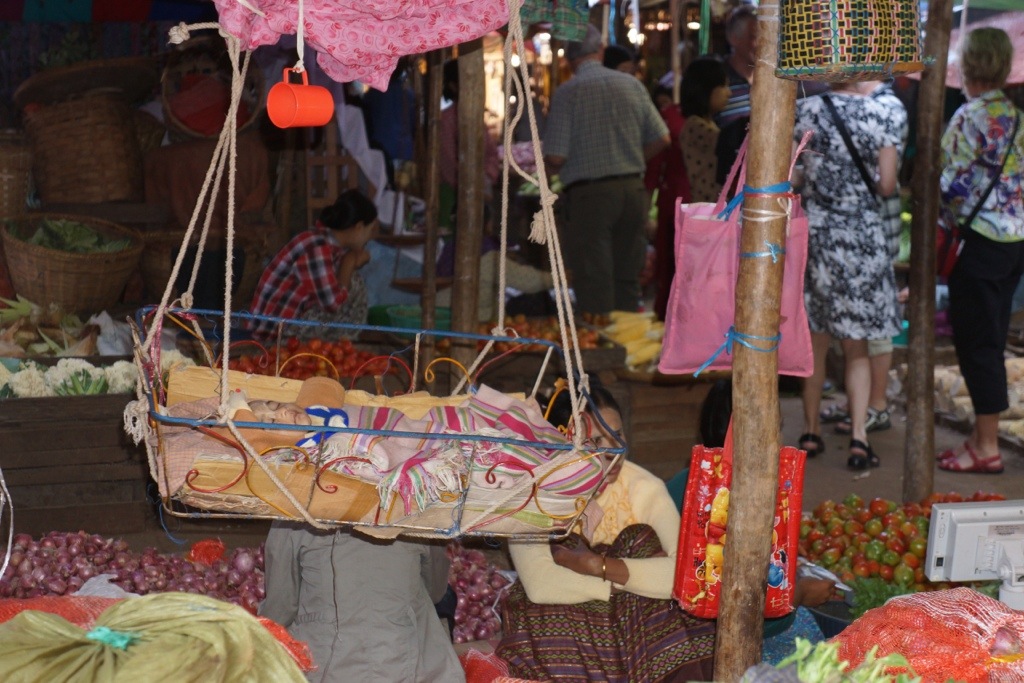
Next we visit the Kyan Sither Cave, dedicated to monks by the 44th king of Bagan. The cave contains some wonderful drawings that we view by flashlight; no photos are permitted. The cave was built on a site identified by a white elephant, a powerful figure. We talk with Ko Ko about the meaning of white elephant in our language.
We move on to the Hit Lo Min Lo Temple, built in 1280. The temple is two stories high and known for its plaster carvings on the outside.
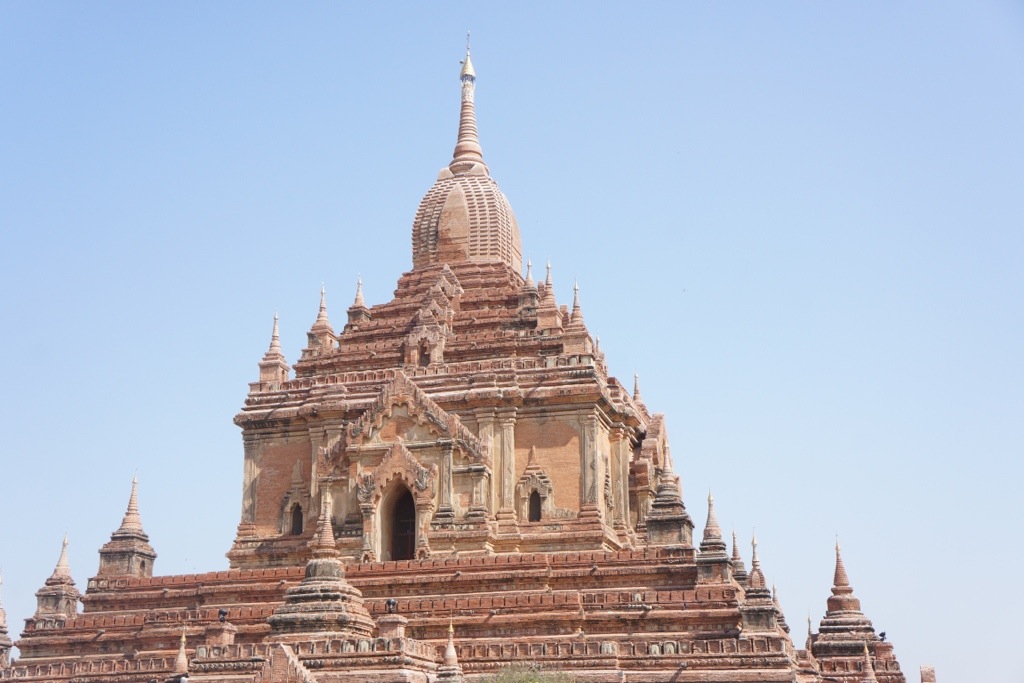
Lunch with Ko Ko. Carol instructs the waiter on how to make the grilled cheese sandwich I request. We talk about Ko Ko’s family of nine children. He has been a guide for three years. Took him about a year to complete studies, exams, etc and he now freelances. When I ask whether he guides mainly Brits, Americans or Aussies, he says that he most often guides Asians who do not speak Burmese, but do speak English.
After lunch, we go to the Ananda Pagoda, the masterpiece of Mon architecture, built in 1091 by King Kyan Sither. The ground plan is a perfect Greek cross. There are four huge standing wooden gilted Buddhas. The two originals stand 31feet high and their faces appear to be serious (for the king) when up close and smile from afar (on the people).
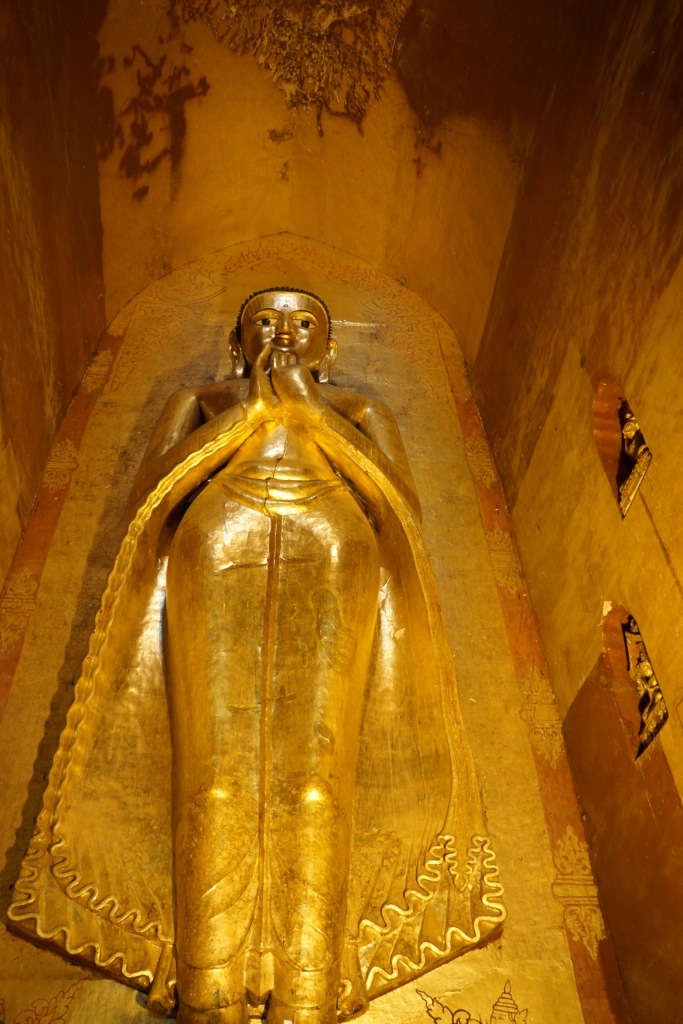
Through phone calls with our Yangon travel agency, we are able to line up a guide for the next two days, to replace Dotty’s friend, whose English probably would have driven us nuts. We walk through what we thought was the festival area (but later found out that there was another one), which had many booths that could be grouped under the corporate name Crap R Us. We do not spend long.
After cooling off and cleaning up for a couple hours, Ko Ko picks us up and takes us to the Shwe San Daw Pagoda, THE place to see sunsets. We climb four stories of very steep stone steps and muscle our way around for a very lovely view of the pagodas at sunset. The way down is only slightly less difficulty (Carol would say more difficult).
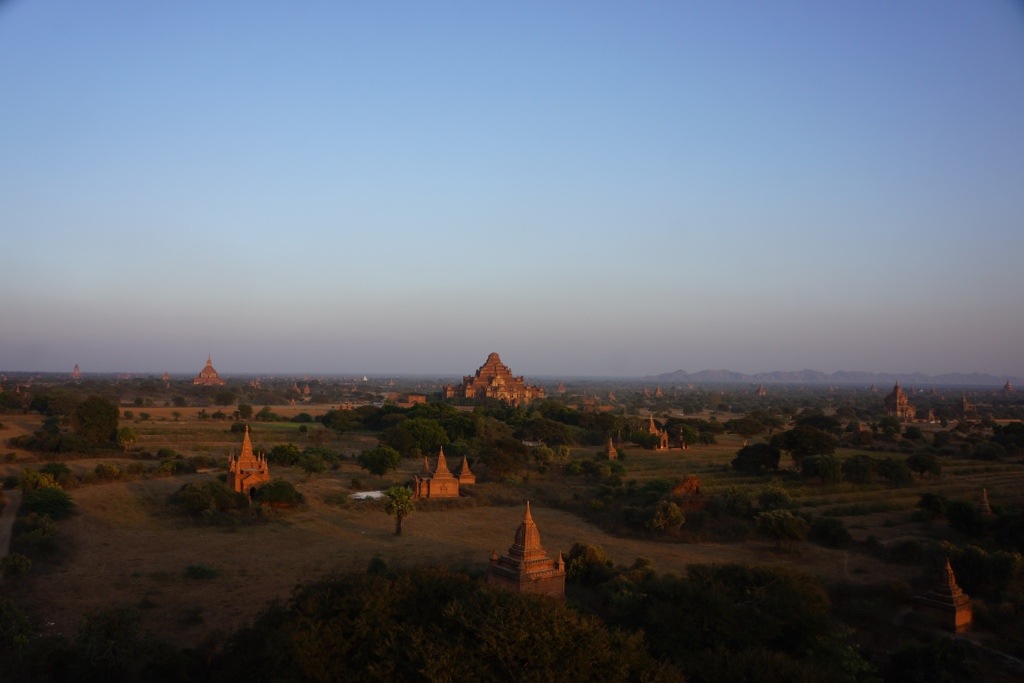
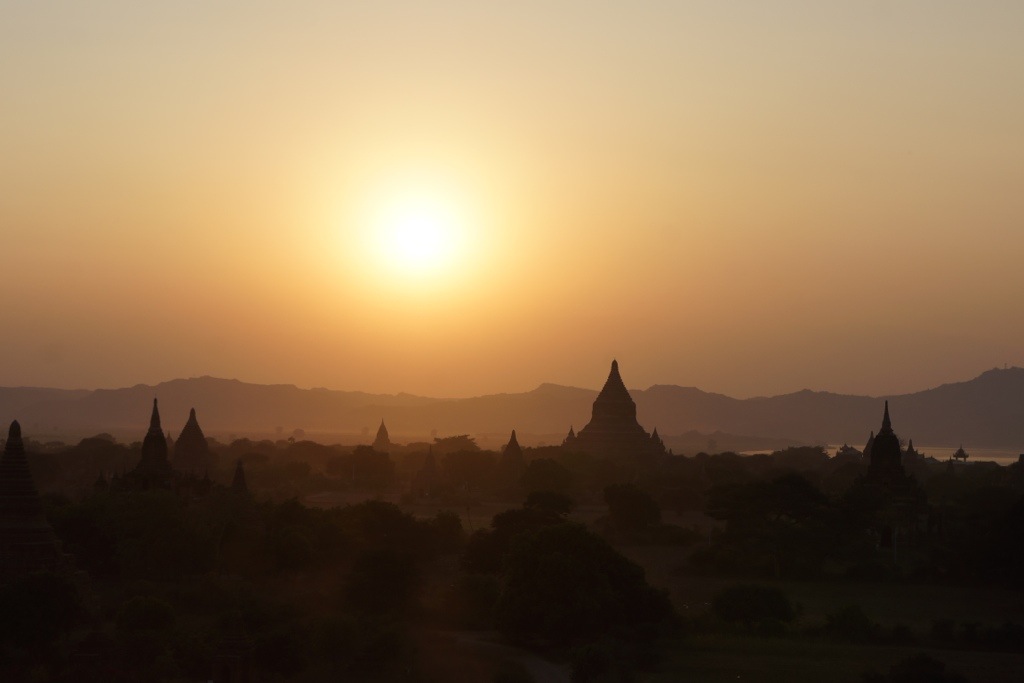
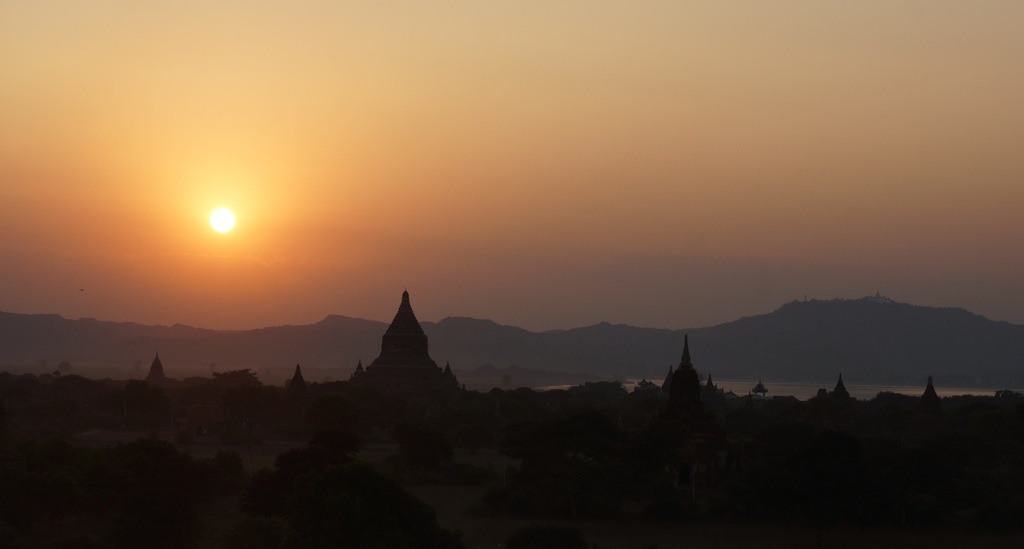
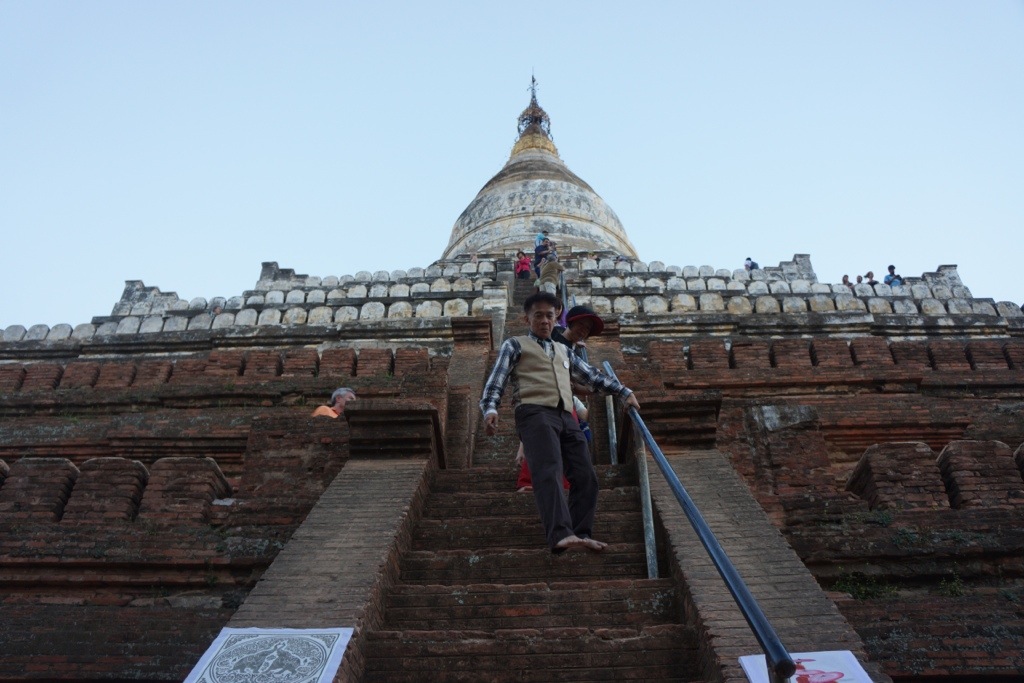
We ask Ko Ko to drop us off at the upscale resort that Bonnie and Tim are staying at and immediately encounter Bonnie in the lounge on her iPad. We arrange to have dinner with them outside on the large deck, and have a laughter-filled evening with our new Brit friends. They say that Carol and I must visit Sri Lanka. We say goodnight and promise to stay in touch.
Trying to walk back to our hotel, we get lost (Carol’s fault, of course), so we walk straight back to the hotel from whence we came and get them to order us a taxi. We are rather bushed and go right to bed.
January 22
Picked up at 5:45 (having again been awaken at 5:10 by chanting, no alarm clock needed). At first, there is some difficulty/confusion trying to find the boat, but we locate it. We say goodbye to our excellent driver and guides, Zo Win and Aung Lin Htet. We give Zo Win a tip and give each of them a lucky $2 bill. We will stay in touch with Aung Lin Htet, and, we hope, host him in the US. Dorothy has suggested that we might write letters of recommendation about Aung Lin Htet, and we’ve said that we’d happily do that.
Walking down a steep hill and up a gangplank, we board the RV Vandabo, a boat with what looks to be a capacity of about 25. It appears that it’s just us and a large group of Germans, which does not excite us. We soon find out that the Germans are Danish, though, and we strike up a conversation with a very friendly former SAS employee named Adda. We later discover that there is also a British couple on board, and some Swiss.
The ship is wooden and quite new. We’d switched to it on Joe Feldman’s recommendation. Before embarking, we watch a group of natives exercising in unison to the leader’s call on the river bank. At first, it’s very chilly, as the sun rises, but we’re dressed for the occasion, having been warned by the Feldmans. The scenery combines barges with pagodas on the shore.
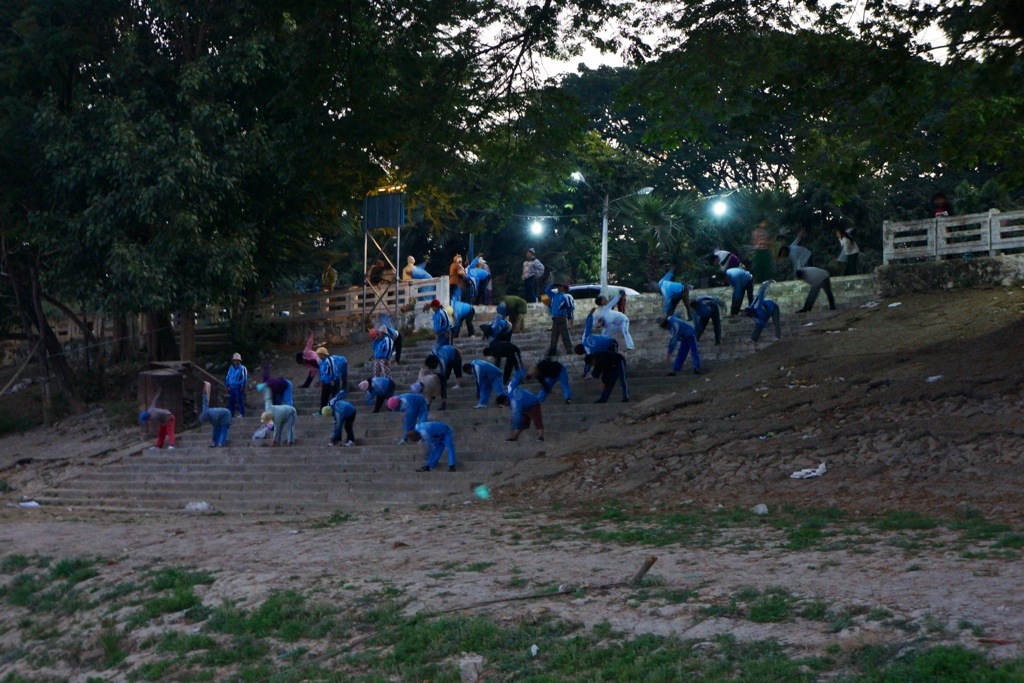
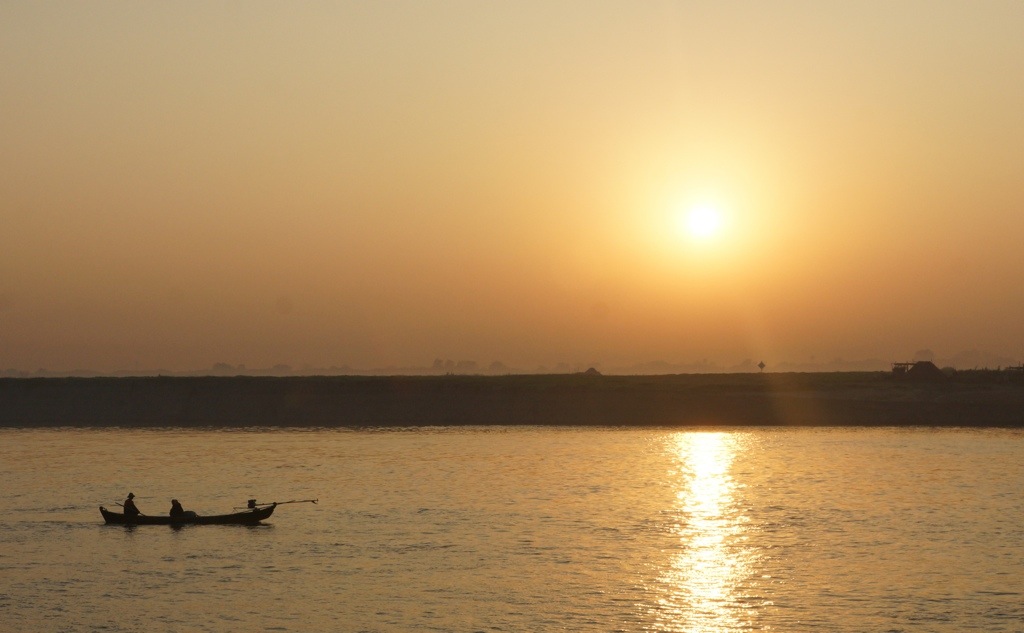
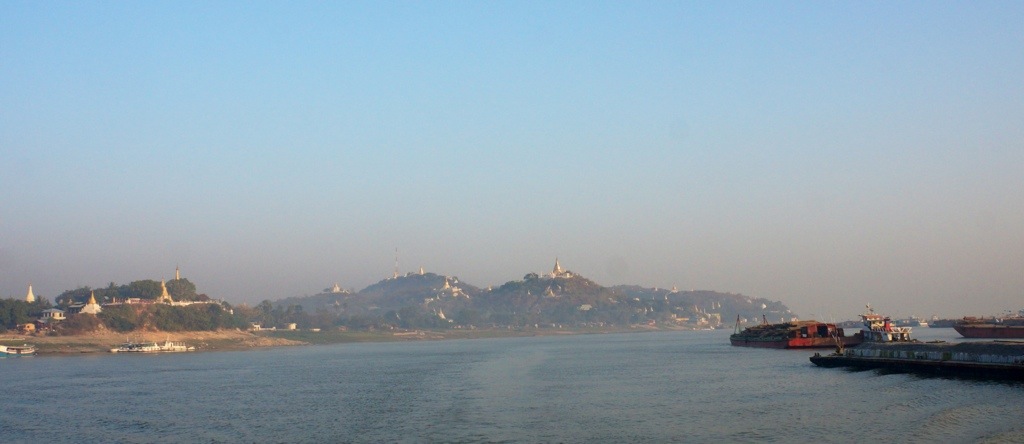
The Danish group is quite friendly, and we talk a lot to Tim and Bonnie, from London, who have traveled very extensively and built a home on the coast of Kenya, near Lambu. Tim was born in Uganda and is a sculptor. Our travel agent did not book lunch for us, which is fine, both because we’re not hungry and because we’re told that the lunch was lousy.
We stop for about an hour at a village called Vandabo, which appears to have quite a thriving business making pottery, on a scale very far beyond the village we visited yesterday. Adda kindly translates what the Danish guide is saying. Many good children photo ops, and a pleasant interlude from the boat. Download photos when we return to boat and get the blog up to date.
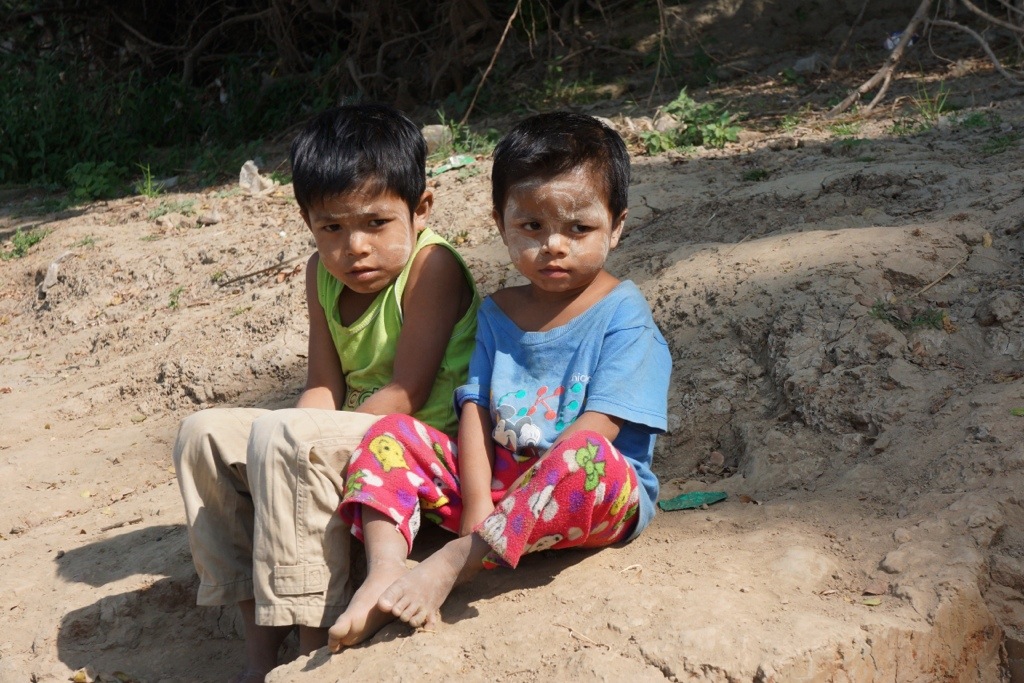
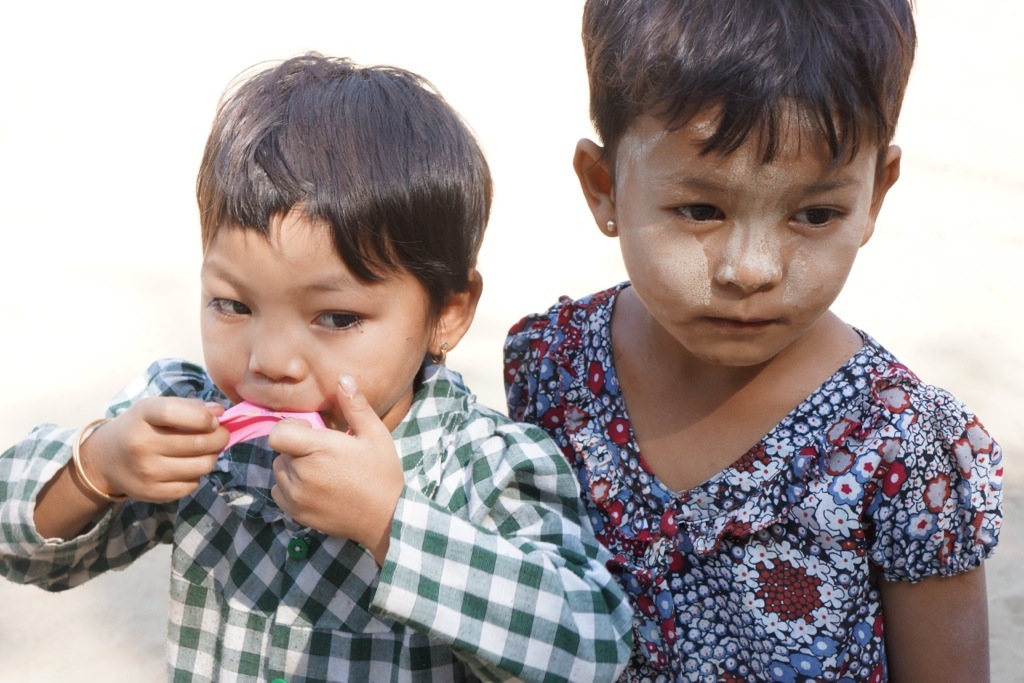
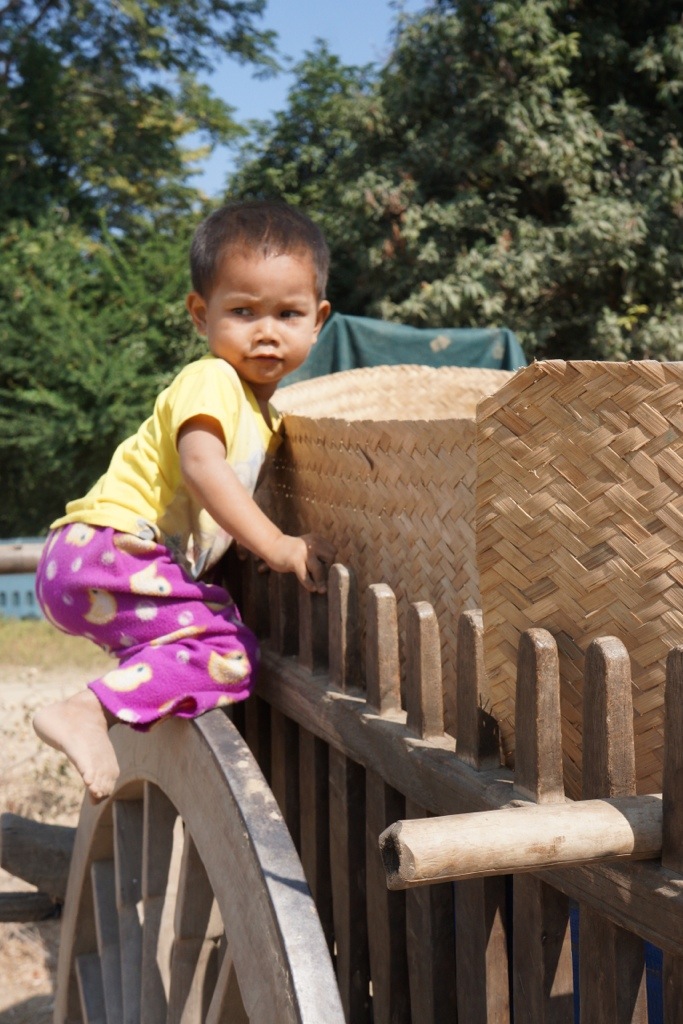
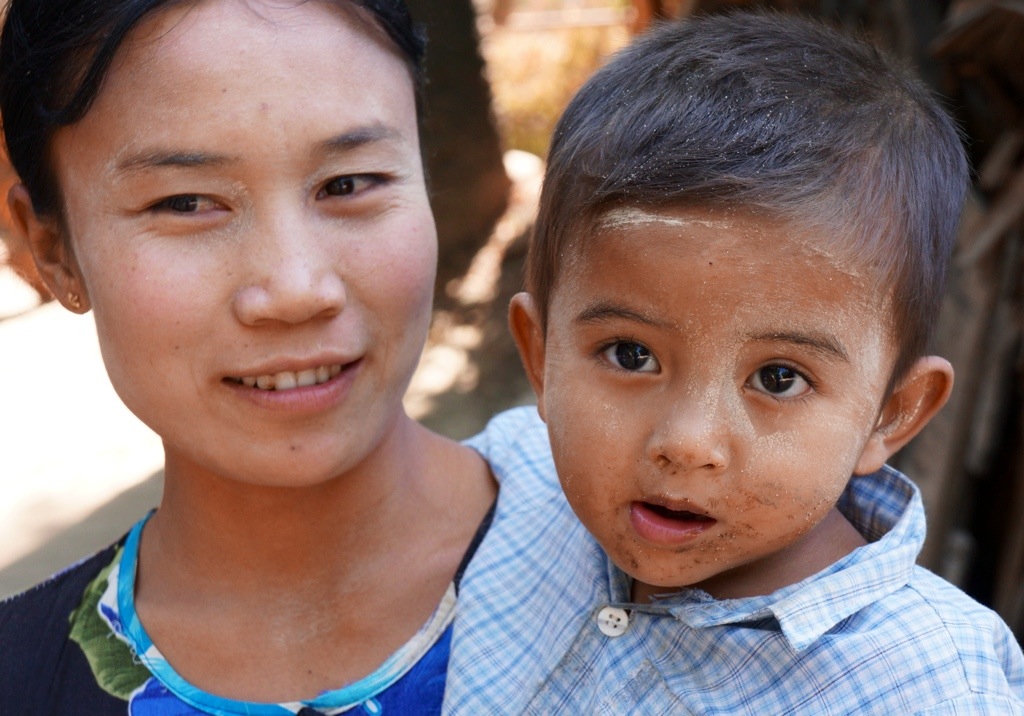
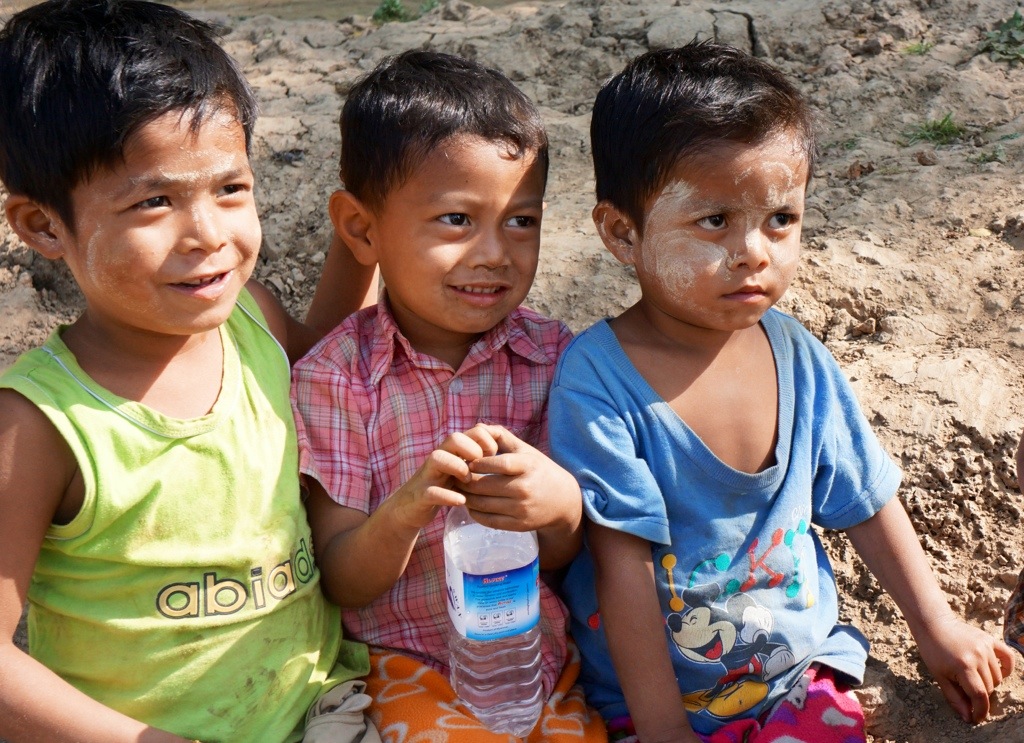
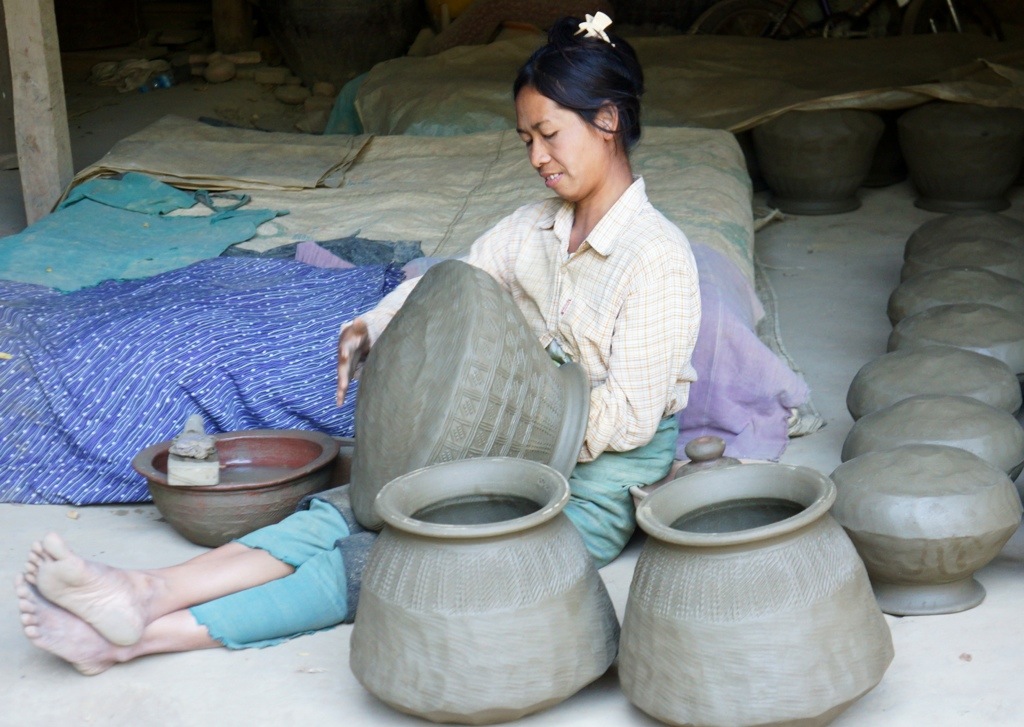
Enjoyable ride down the river with boat and shore scenes, the weather changing from hot and sunny to pleasant to chilly as the sun sets, completing the sunrise to sunset day.
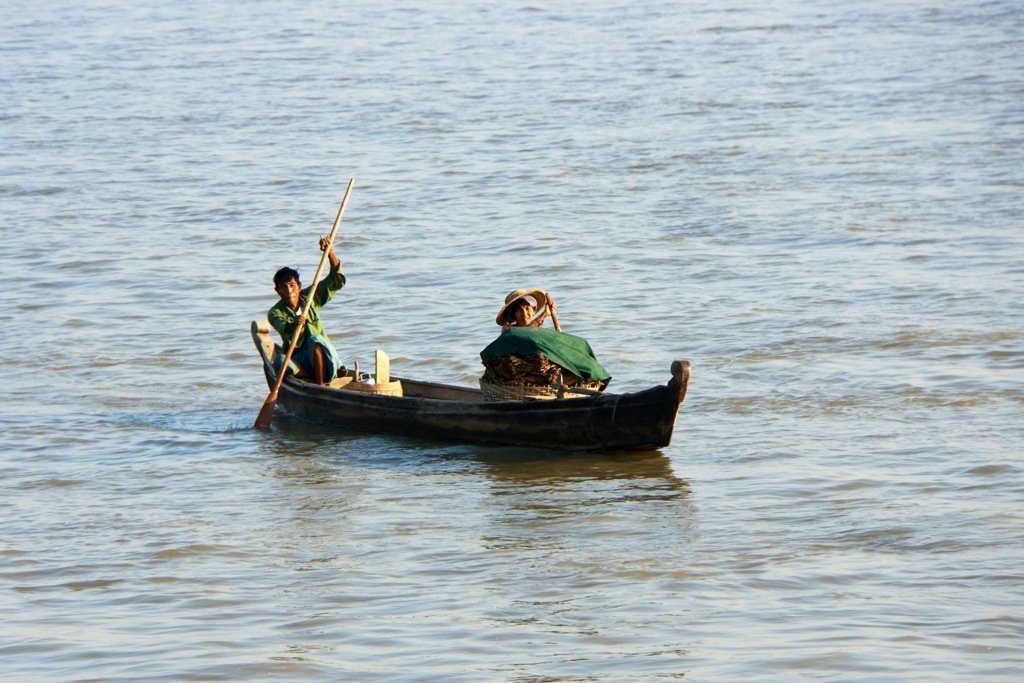
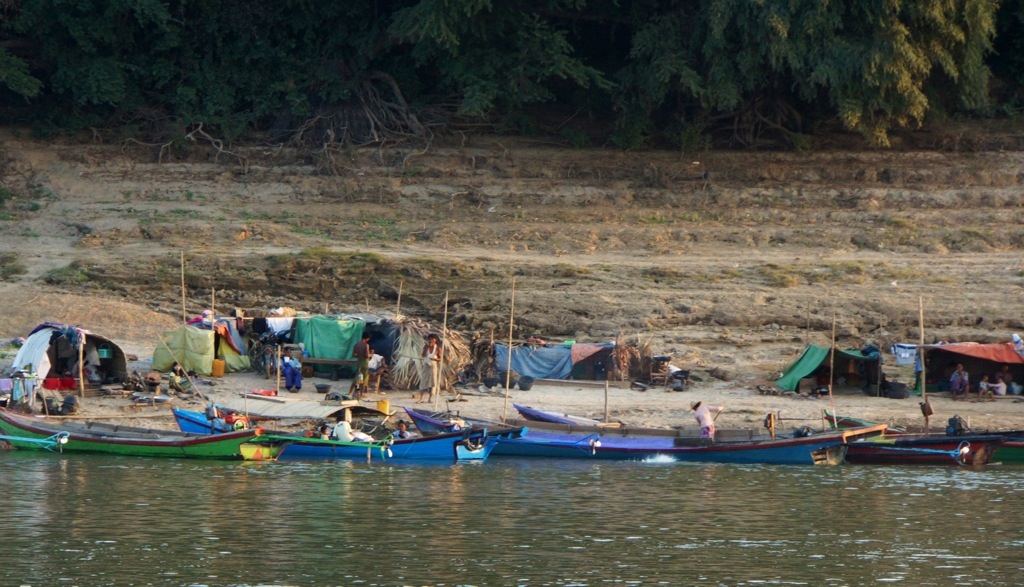
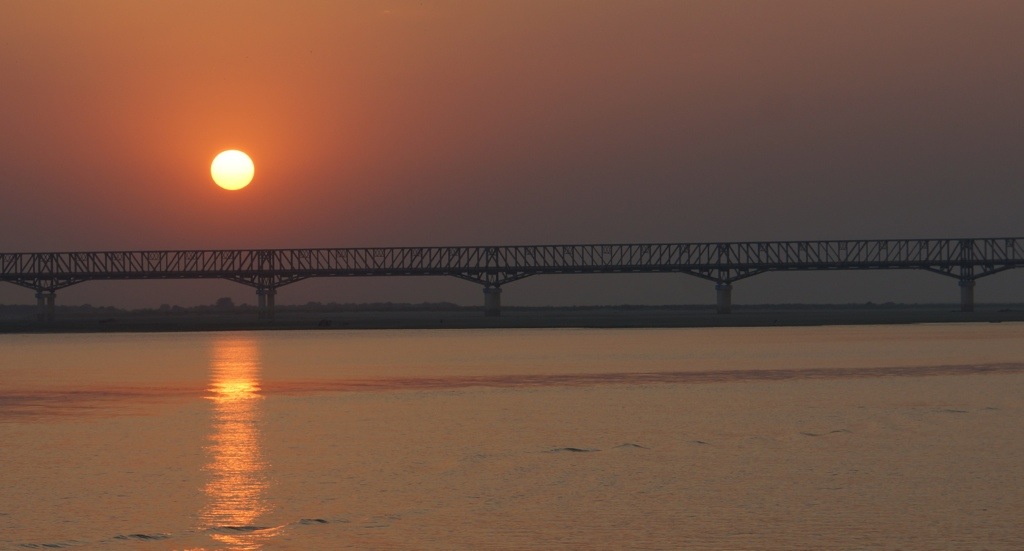
At 6:15, we are about half an hour from port, when we run aground on a sandbar. Futile efforts to get loose, free rum sours to calm the passengers and finally they send for four boats to come out, three for the passengers and one for the luggage. Much laughter with Tim and Bonnie, the English couple. Bonnie is upset about not getting to the great hotel they’ve booked and missing their scheduled massages and dinner. I get somebody to call U Thein Tun Oo, Dorothy’s friend who is waiting for us at the jetty. He has already learned what has happened and says, no problem, he’ll wait.
When the boats arrive, Bonnie pushes her way to the front and instead of their loading three boats with people and a fourth with luggage, she convinces them to load the four of us with all of the luggage into the motor boat first. The motor boat ride is slow, lasting forty-five minutes, but the conversation with Bonnie and Tim is hilarious. We finally arrive at the jetty at 10:15 and are met by U Thein Tun Oo and driver. The former is nice, but extremely difficult to understand. He tells us that something has come up so that he can’t be with us tomorrow, but another guide has been arranged.
We check in to a very nice hotel, the Aye Yar River View Resort, and are informed that we will be picked up at 5:45 for our balloon ride tomorrow morning. We go up to the room and shower. I blog and shoot off an email to Dotty, telling her my concern about our being guided for three days by U Thein Tun Oo, given the level of his English, and asking whether anything might be done about that.
January 21
(Note: If you read the January 20 post without photos, you may wish to look back at them. Because of lack of Internet connections, I’ve been unable to post for several days, so you may see three or four posts at once. Sorry about that.)
Chanting awakens us again, just after five (having gone to sleep again after the 3AM dog barking), but as we were to do an early tour of the market and port, we did not mind. After breakfast, though, Aung Lin Htet gives us the disappointing news that there’s no market today. So, after checking emails at Aung Lin Htet’s and unsuccessfully trying to load photos to the blog, we pick up Nai to head for the villages.
Watching the city and area wake up is interesting–monks in vermillion robes carrying their alms baskets, small buses jammed full of people, hordes and hordes of motorbikes, cars, bicycles and, as we leave the city, increasingly horse and ox-drawn carts. Aung Lin Htet explains that monks have certain places they return to for alms, typically cooked rice. Nuns, in pink robes, travel in a line as a group and bring their raw rice back to the monastery to be cooked.
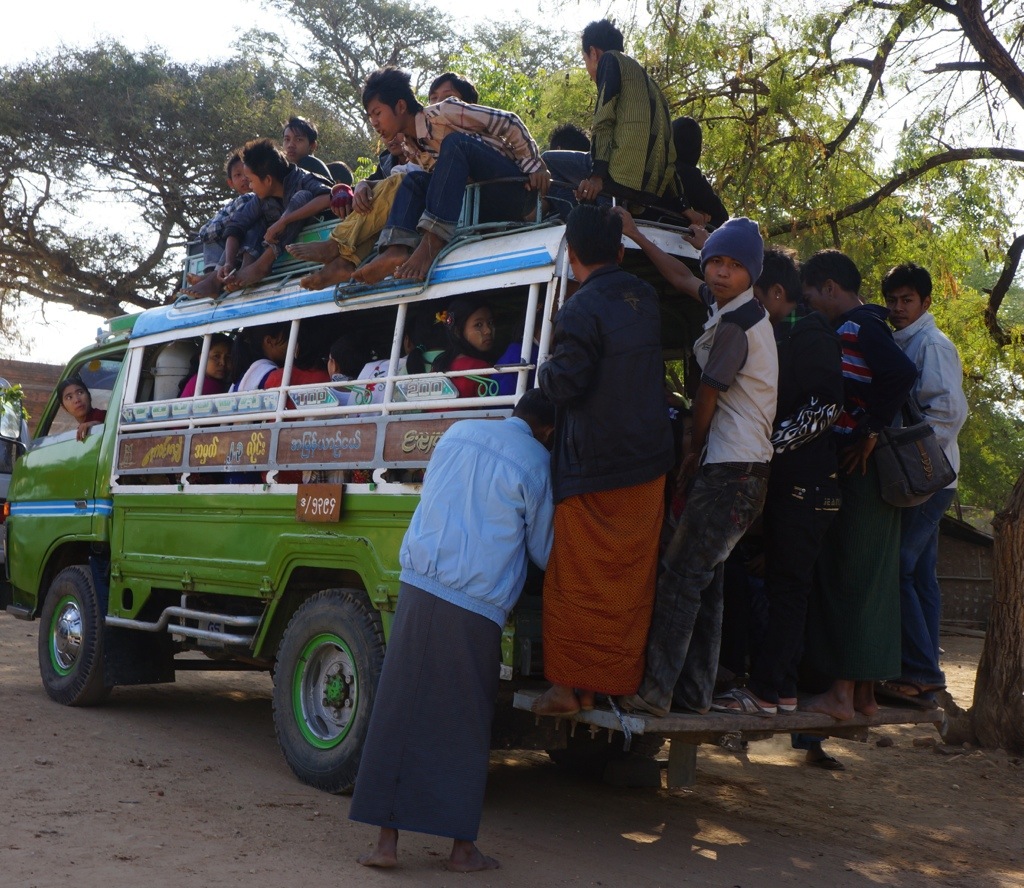
Part of our trip is along a toll highway, but eventually, we leave that and drive on narrow, badly-paved roads. Unfortunately, this post is going to be a whole lot sketchier than it should be because I just inadvertently erased all of the notes I’d written in my iPad yesterday. Shit. So, I’ll write this without the names of villages and people (which you may not care about anyway) and add those back at a later time.
The land we pass through is arid, farmable only in the June-October rainy season. During other parts of the year, many people move to other areas to find work.
Our first stop is at a monastery school that houses some 430 students, age four to sixteen. The government recognizes, but does not support, the school. Recognition makes it possible to transfer schools, to take government tests and to gain the necessary credit for university.
We are ushered into a large room, where we meet the head monk, a man of about fifty. He has significantly expanded the school during his tenure there. (Later, we see young people he has hired making brick blocks by hand and a large line of thousands of them, which will be used for future building.).A large tray of food is brought out for us, as we sit asking the monk questions. We tour the school buildings where we see/hear students reciting their lessons in unison, aloud. The students seem somewhat uncomfortable with our presence. There is none of the animation, laughing and horse play that we typically encounter in Ghana. In one of the older classrooms, students are working on computers.
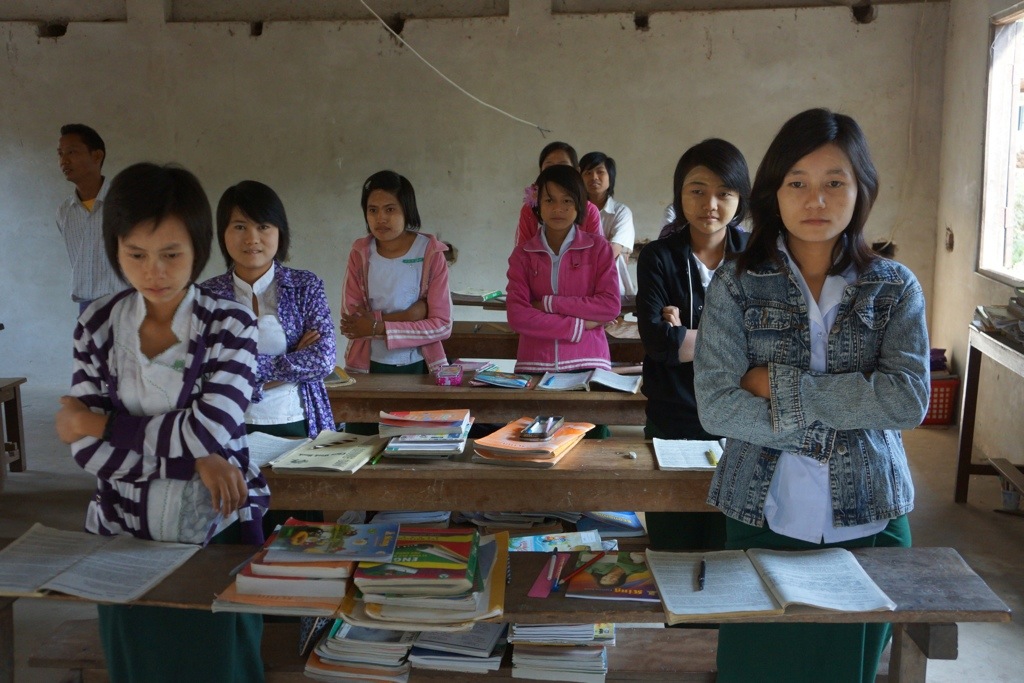
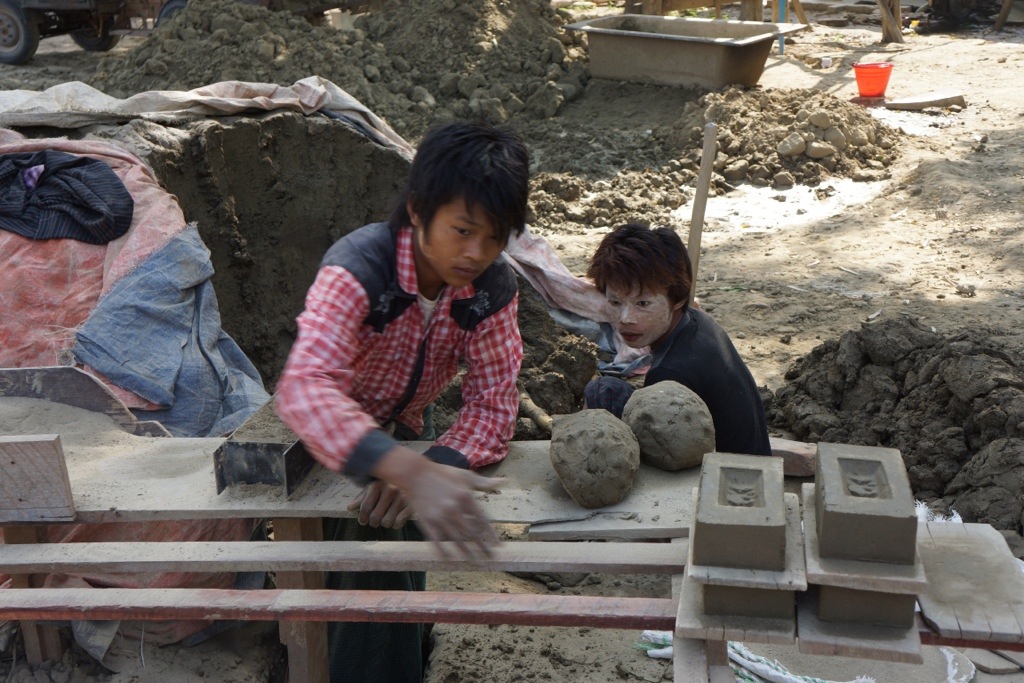
We drive from there to Nai’s home in the village. It is a nice, clean home, with a flat screen TV. We’re served lunch by Nai’s mother, a very nice-looking woman who looks perhaps half her age; she could be his sister. Nai has invited a friend who works for the NLD in a nearby village and a young woman who works in a library that Nai supports. Neither speaks English. Nai and Aung Lin Htet are pictured below.
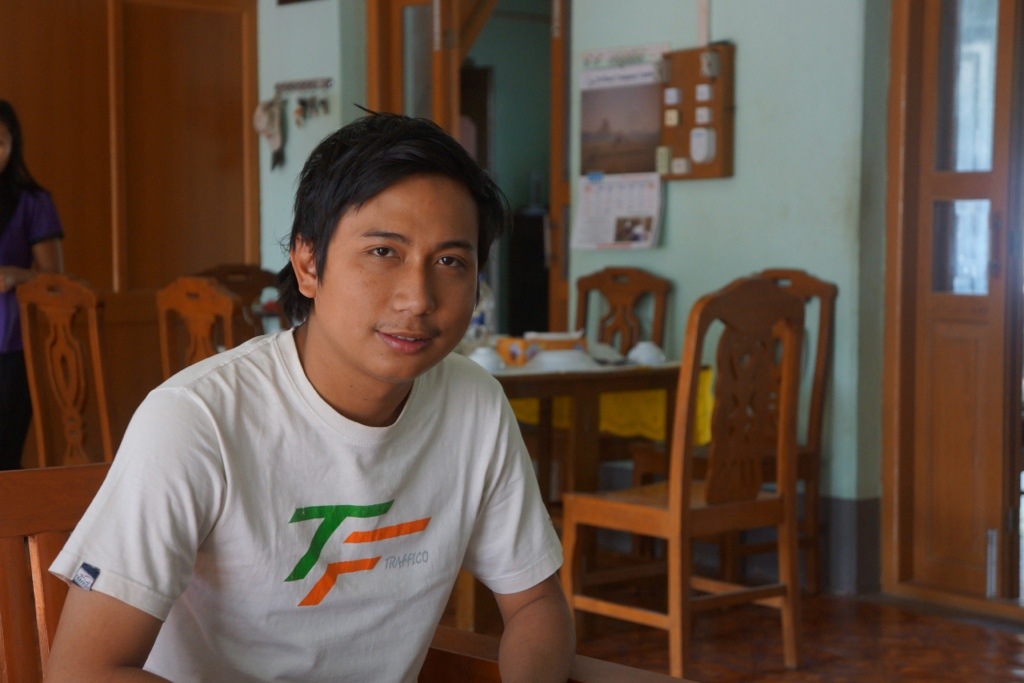
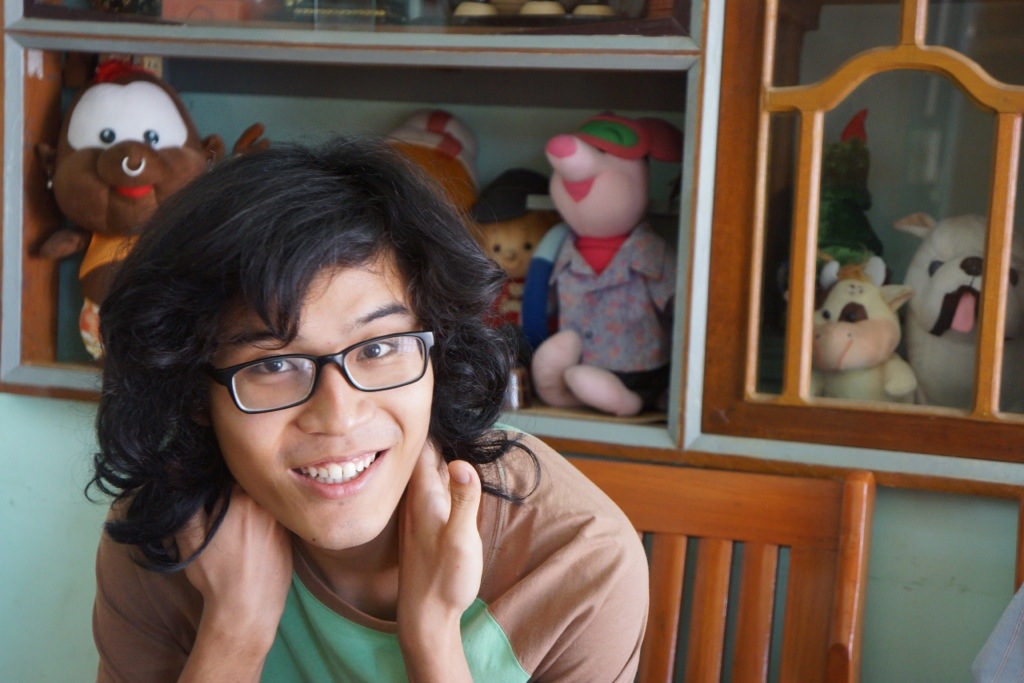
Nai lives in this home, not in Mandalay, as we had thought. It turns out that, while he spends about six hours a day on NLD work, he is not paid for it. He has an internet store that he runs for money. Nai’s mother has a gold and jewelry store nearby. His father died 17 years ago, when Nai was ten. It’s very unusual for somebody from a village like Nai’s to have attended PCP in Yangon.
After lunch, we drive to another, smaller monastery school, which has about 80 students, about a quarter of whom have no parents and live at the monastery. Again we meet with the head monk and again are offered food. We do a brief tour of the school, which includes a class of very cute pre-schoolers. As with the other school, the government provides no support to the school.
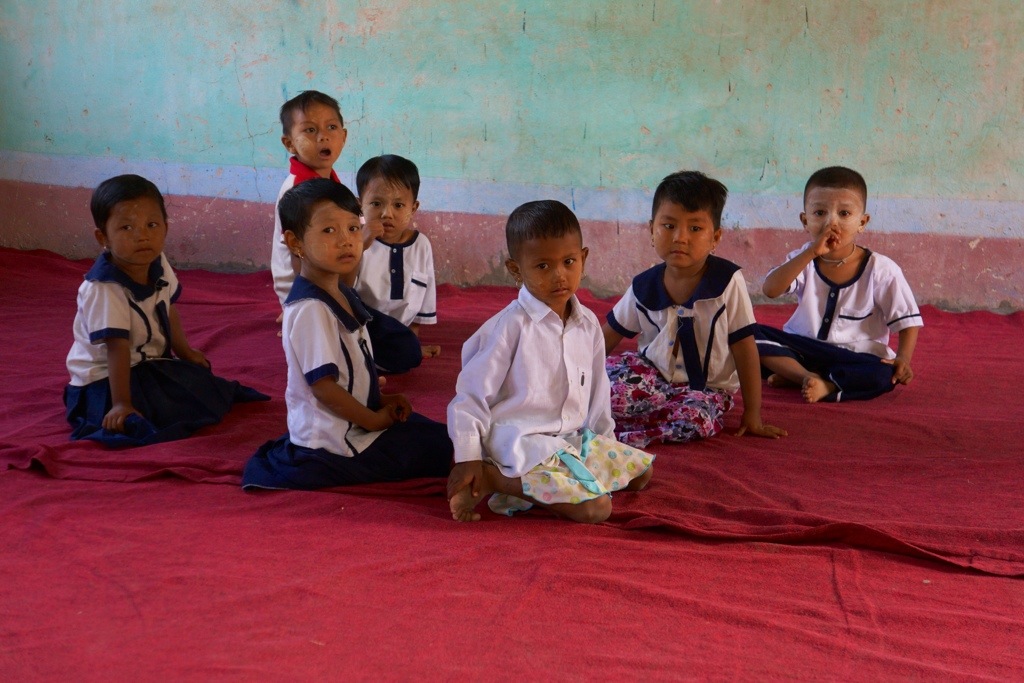
By now we are traveling on bumpy dirt roads, quite like those we need to traverse in Ghana, and arrive at a farming village, that also produces ceramic ware and baskets for the area. We sit in a shaded area and hear about and see the cigar-making that they do by hand. In a day, a person can make 800-1000 cigars and is paid about a dollar a day for their work. The land and operation is owned by people outside the village, and workers do not share in any of the profits. A good part of the village of 1500 has gathered to watch us and listen to our discussions. Clearly, we’re the biggest thing to hit town in a long time. People are friendly and smiley, but many are shy about having their pictures taken.
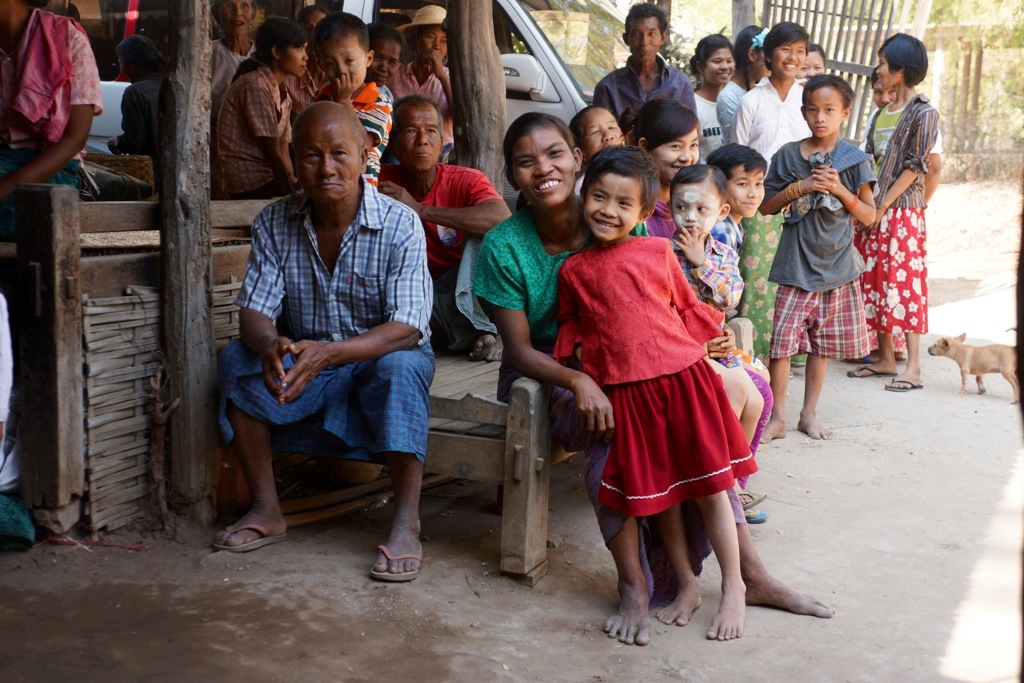
After we finish talking about the cigars, we are driven a short distance to see first the basket making, which is done by a small group of people who cut, strip, soak, bend and weave the smoothed, thin strips of palm bark into baskets. Next, we drive a short way to where dirt brought from other parts is made into mud, and in a process of many steps, is dried several times, put into piles, and molded into pots. Along the way, Imperfect vessels are discarded.
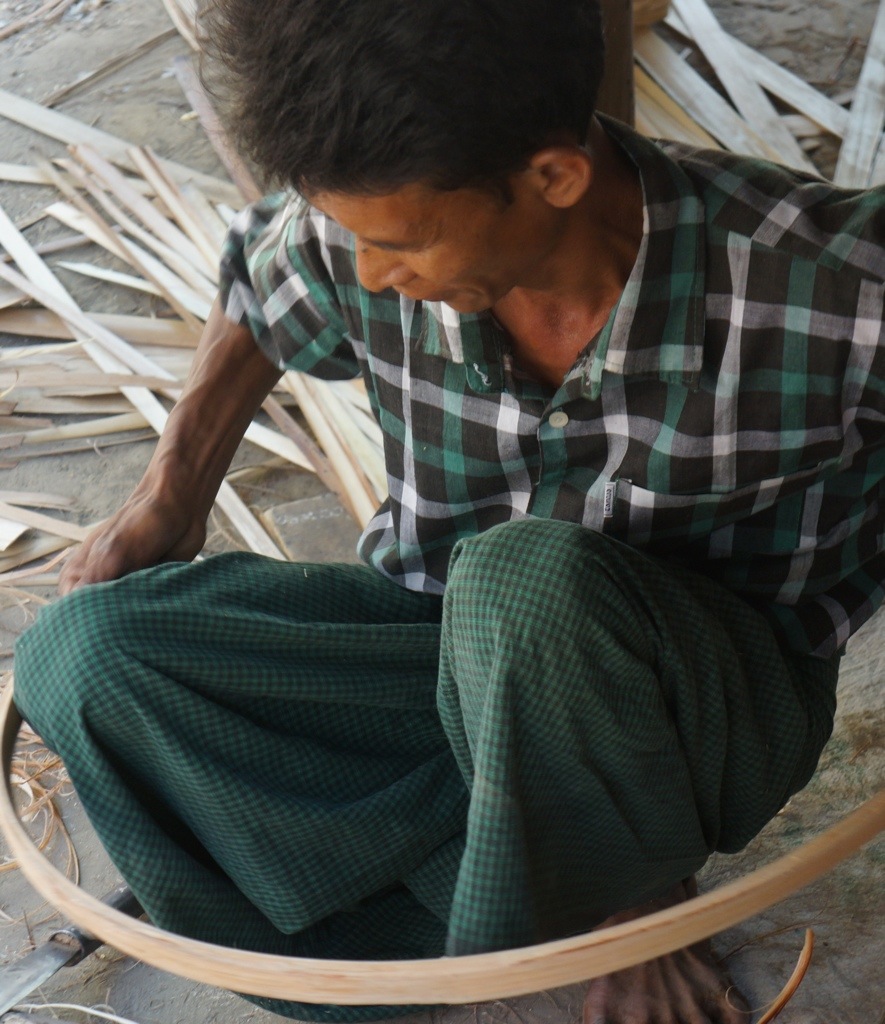
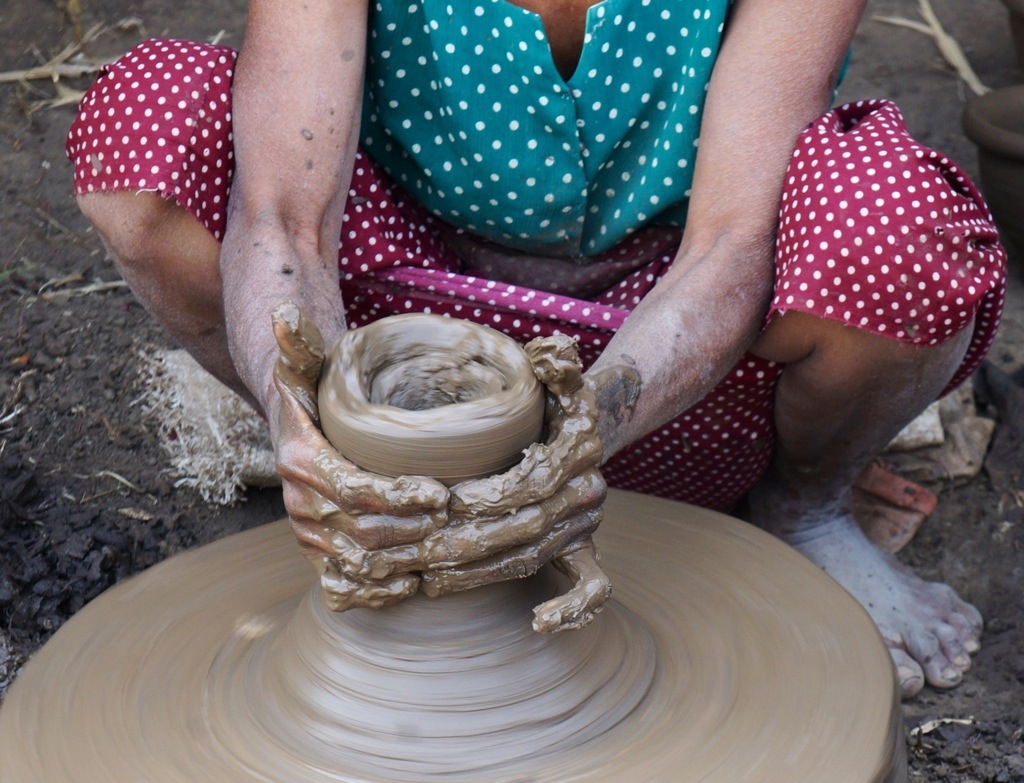
We drive past some quite nice houses, very different from the thatched village houses, which Nai explains are owned by local people who have to work in other countries to afford and support the homes. We stop at Nai’s mother’s very nice jewelry store to say goodbye and for a bathroom stop.
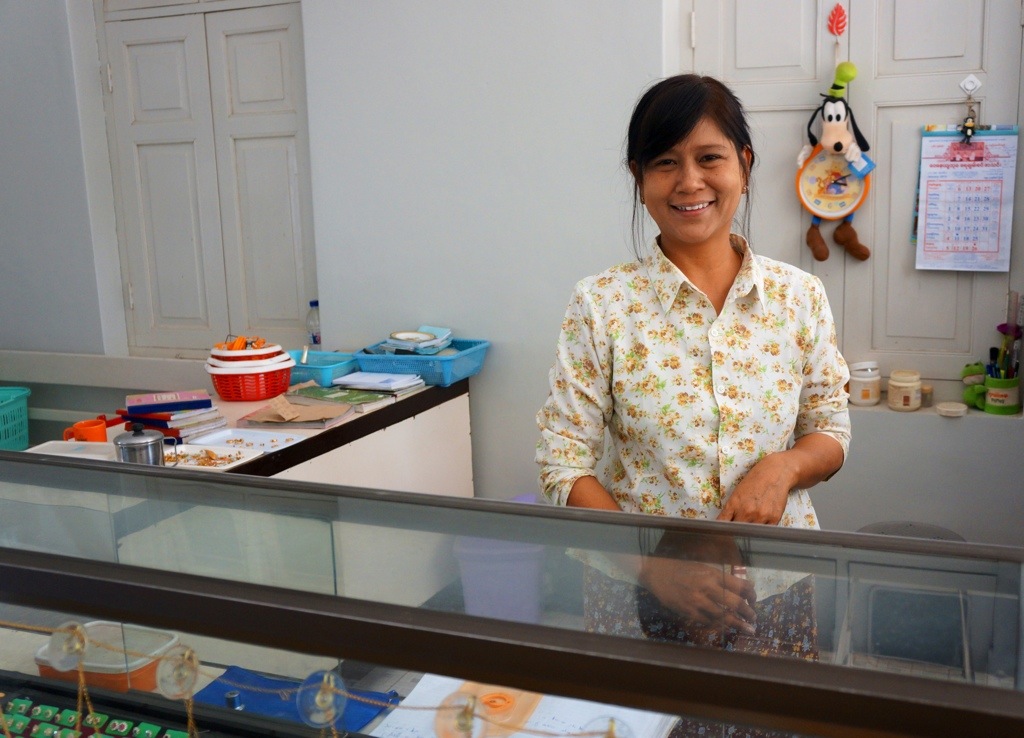
We drive on to another village, where petrified wood, found buried in the earth is mined, cut and worked into beads that are sold for jewelry in Mandalay and elsewhere. The final cutting and polishing of the beads is done by young women sitting and bending over in what looks to be incredibly uncomfortable positions to the very loud whirring sound of machines that the women use to do their work. We buy a nice, large band of painted beads for Carol for about six dollars. Probably killed her not to feel that she could bargain.
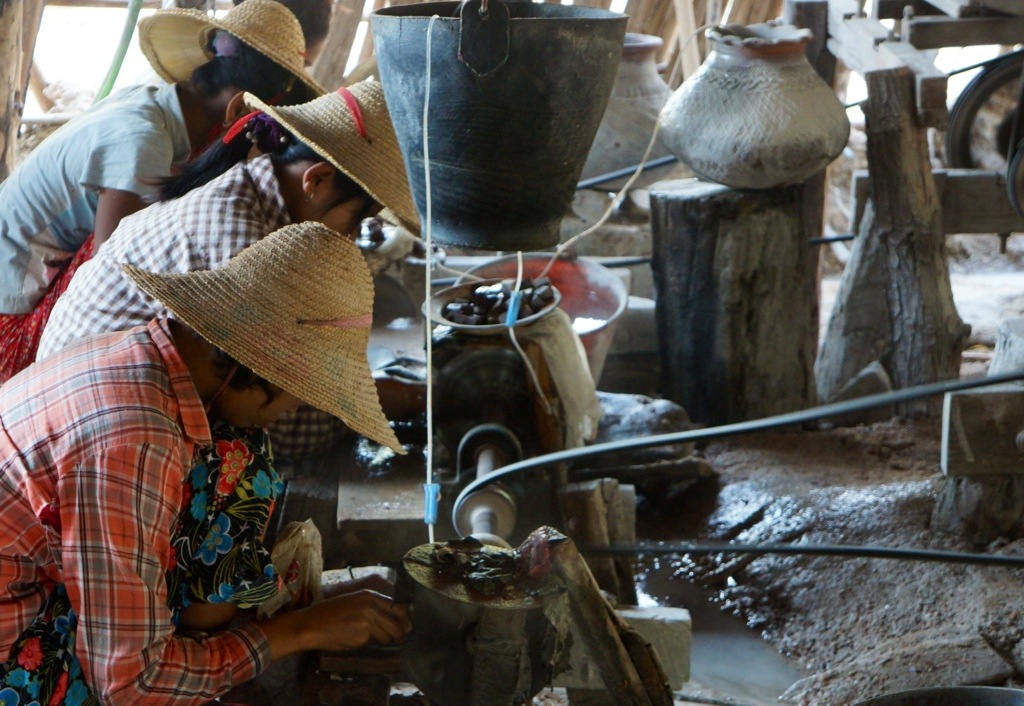
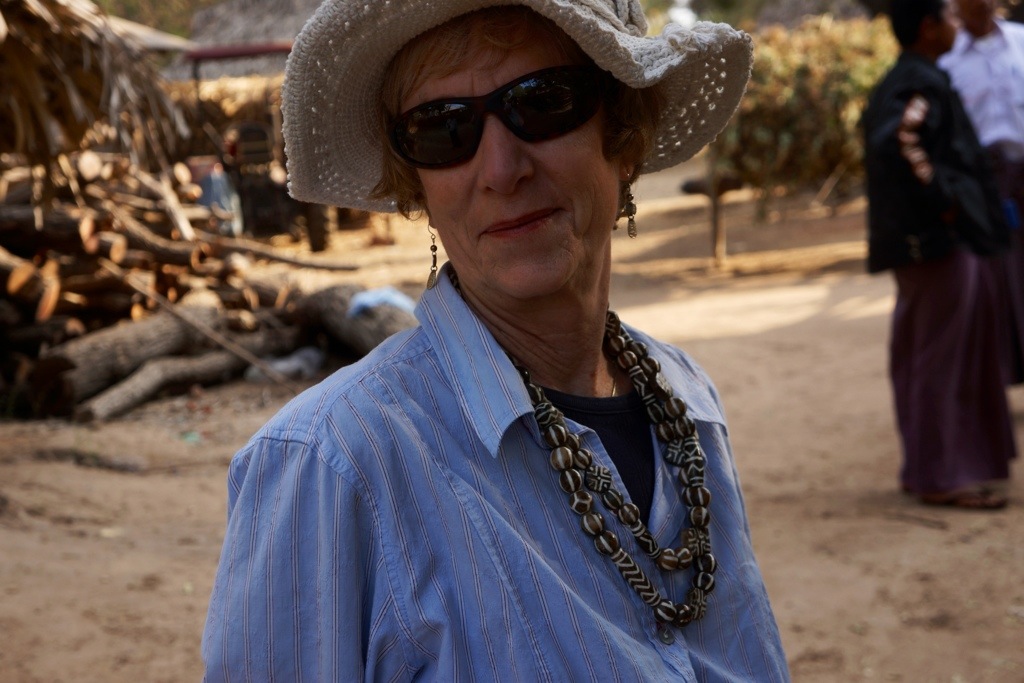
Nai is staying in his village, so we say goodbye to him here, thanking him for all of his efforts in setting up meetings for us. We give him some money for the NLD, which he says he will use to support the education we have seen, since foreigners are not allowed to contribute to the NLD. We also give him seventy dollars to contribute to the environmental activists/former political prisoners with whom we met, which we have calculated will be dues for Carol and me for five years. Nai says he will confirm by email how the money has been used.
As we drive away from this village, Aung Lin Htet tells us that we have been followed by police, ever since our meetings with the NLD and the former prisoners. They have questioned our driver, Zo Win, about us in several places. Nai is currently talking to the police, telling them if they have any questions, to ask him. I joke with Carol that we may soon be former political prisoners ourselves, but that I won’t mind, as long as they allow me to blog.
We drive back to Mandalay, arriving in rush hour. We stop to change some money and, after a short spell at the hotel, are picked up for dinner with Aung Lin Htet at a European restaurant called the Koffee Kaffe. Back to the hotel by nine to pack for our early departure to Bagan tomorrow.
January 20
Awaken early to chanting outside. Breakfast on top floor of hotel. Picked up at 8:30 and stop by Aung Lin Htet’s house for wifi connection to check emails.
Stop by place where gold is being hammered by hand in order to make thin sheets for gold leafing.
From here we drive to Mahar Myat Mu Ni, Myanmar’s second holiest pilgrimage site, which houses a 4-metre high Buddha statue, made of gold and decorated with precious jewels. The image was brought from Rakhine State, southeast of Mandalay. People file by (men only) and leave small sheets of gold leaf to be added to the Buddha.
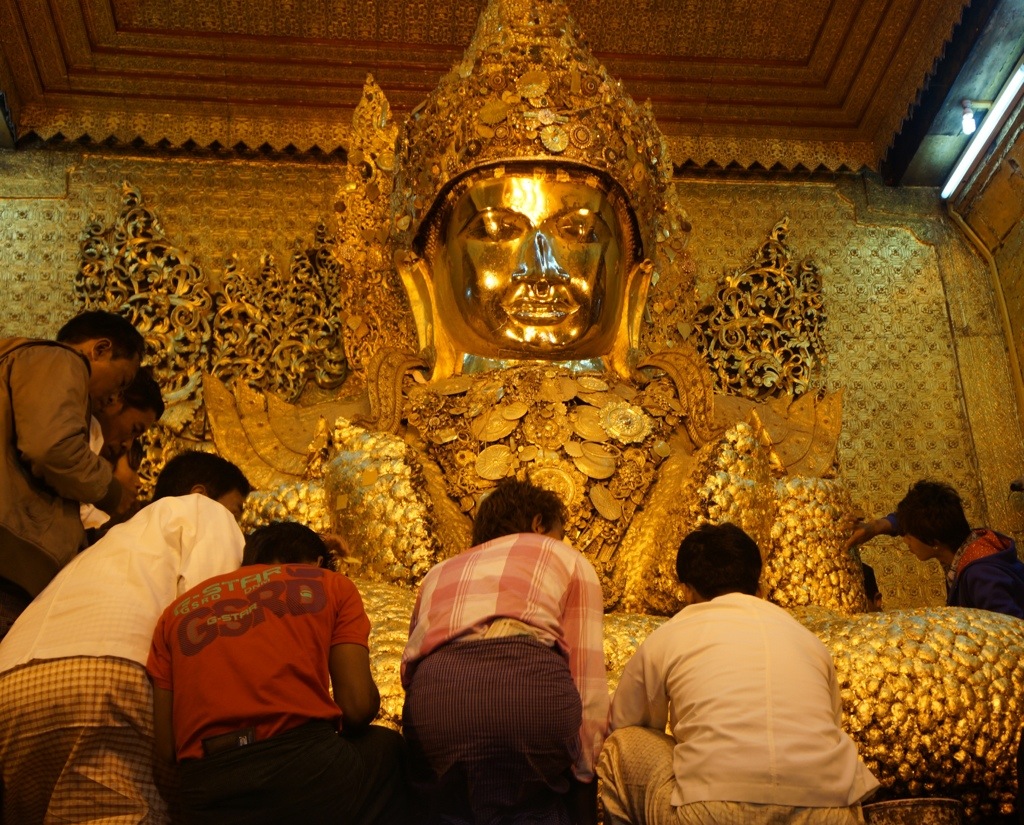
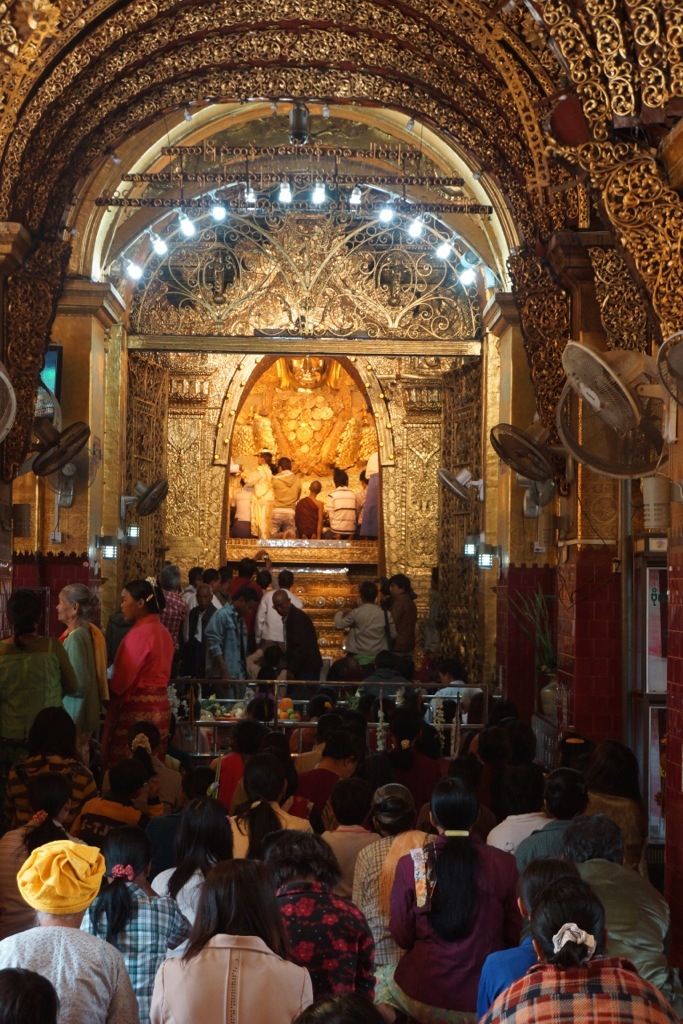
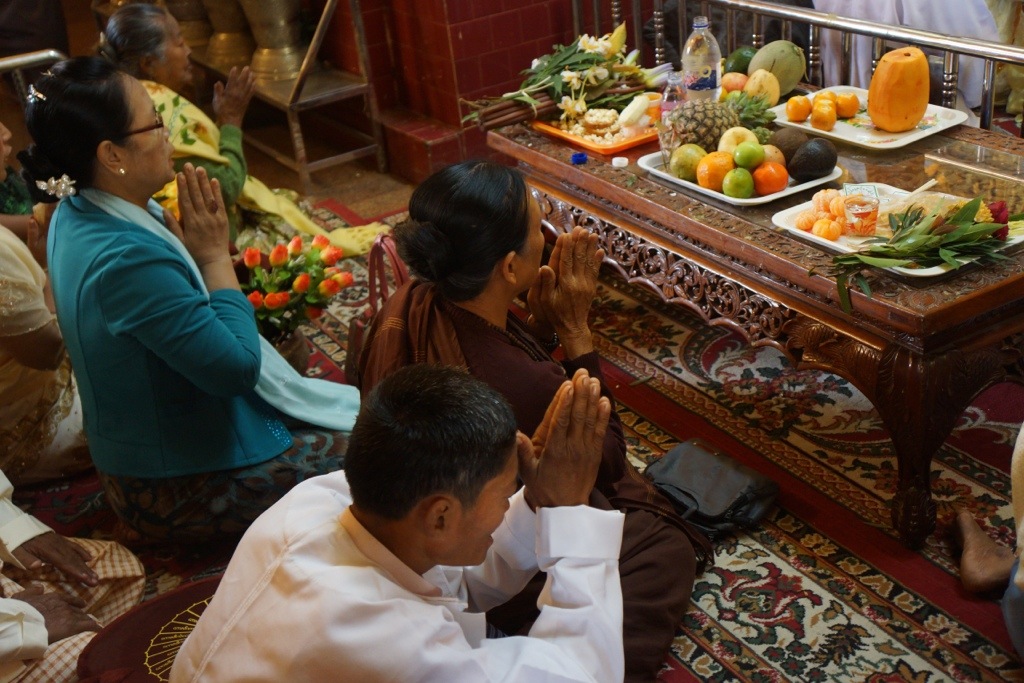
We also see a parade of small children being celebrated as new monks and nuns. It turns out that the cute little girls in yellow are little boy monks, adorned as if they were small kings.
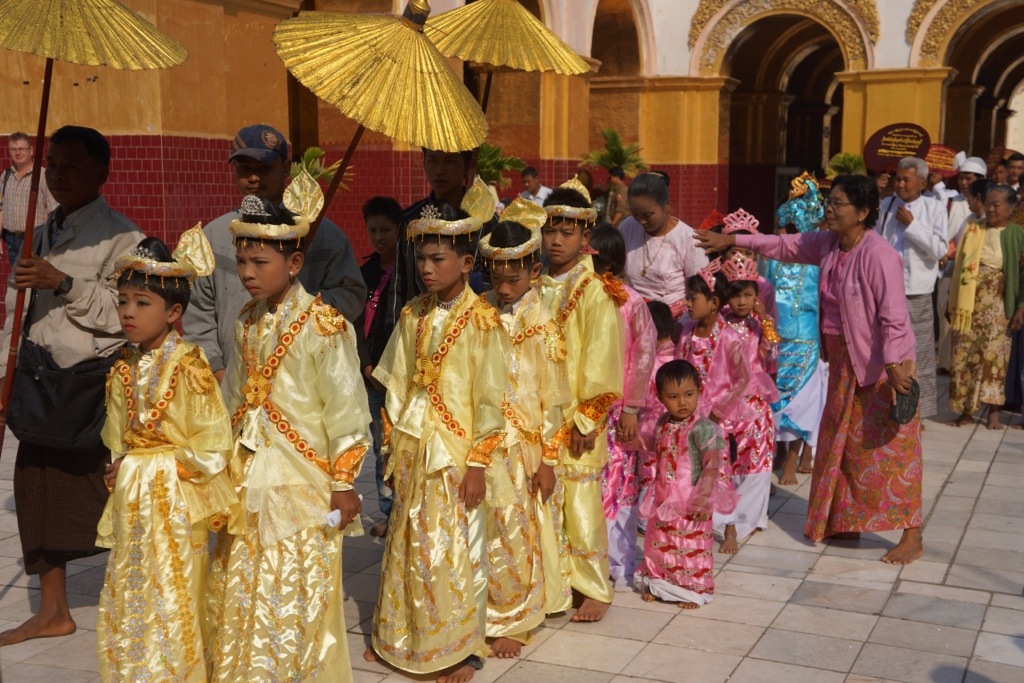
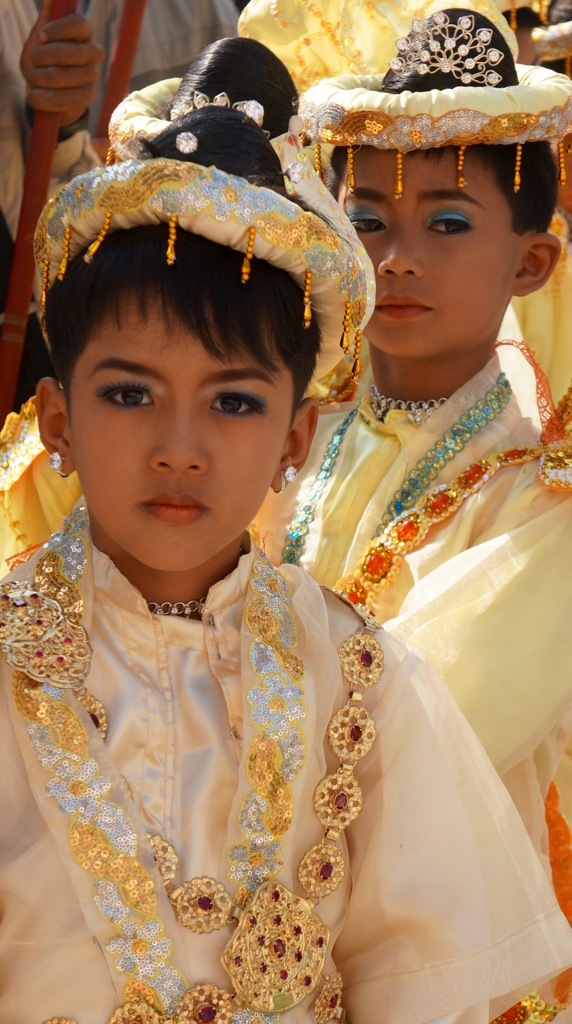
This pagoda also houses bronze statues won as war booty. People, often carrying small children, file by these statues, rubbing the statues and touching themselves, believing that various body parts will be healed through this ritual.
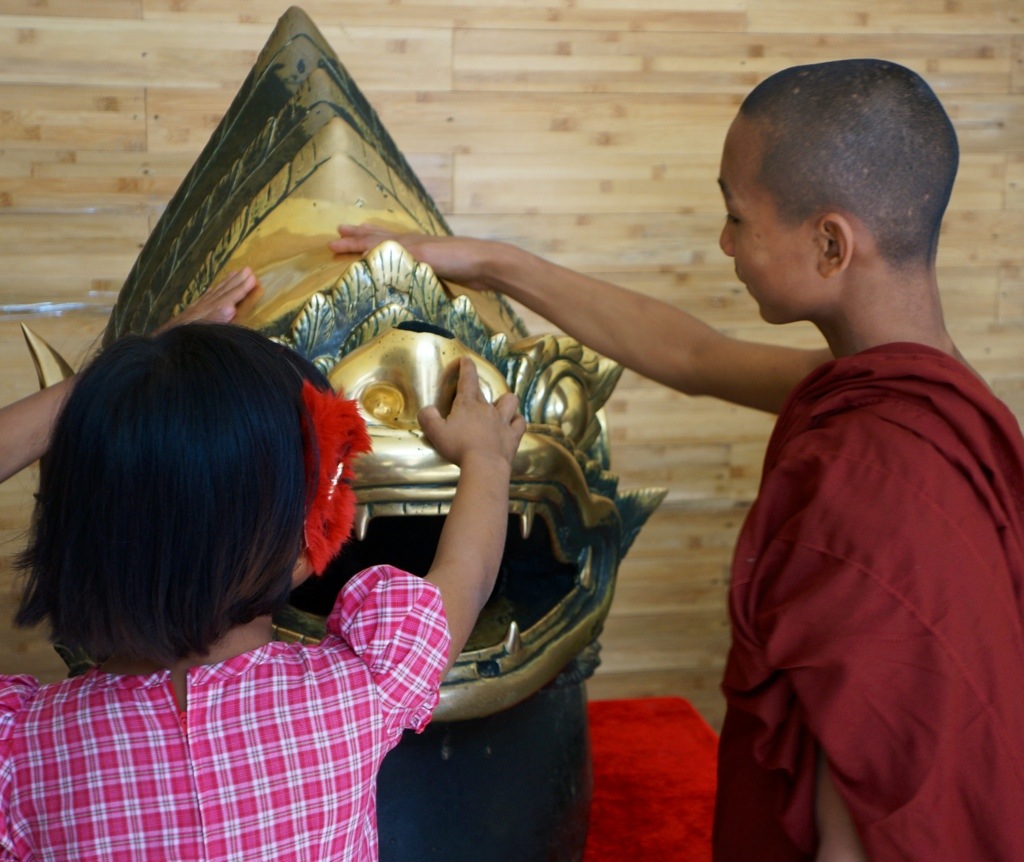

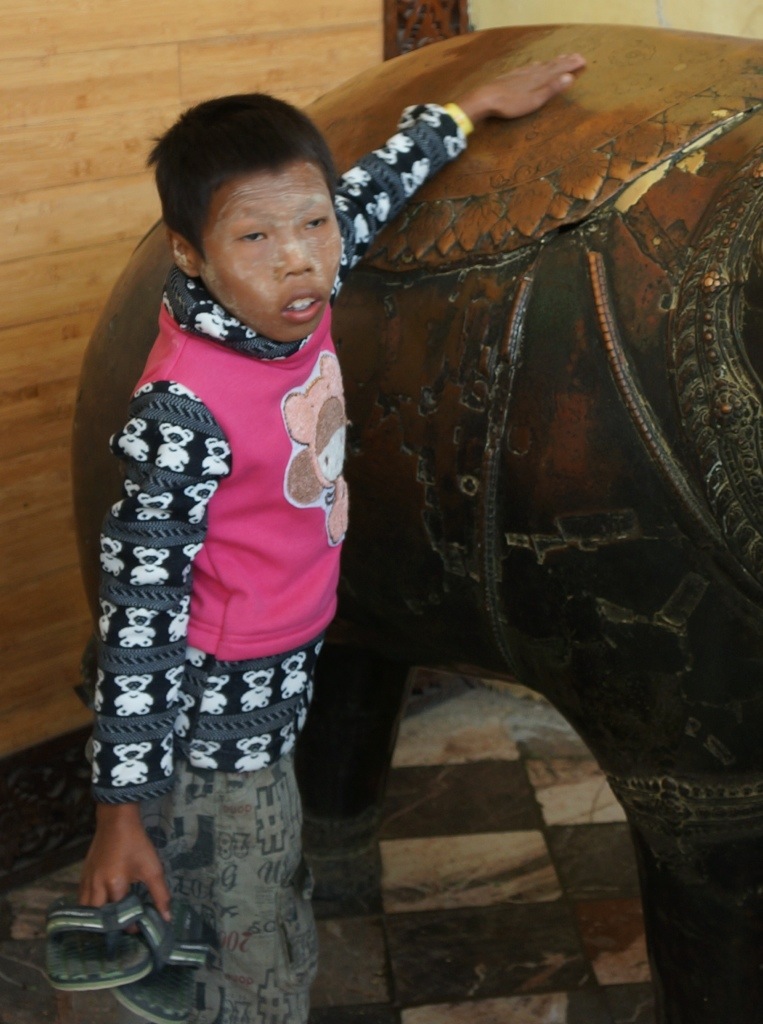
From the pagoda, we drive to the home of Dr. U Tin Maung Kyi, a former urologist, with wide interests including puppetry, cartooning, cultural history of Burma and archeology. He has written on a wide range of subjects and lectured in other countries, including at Brown and Columbia in the US. To say that he is a character would be greatly to understate matters. He regaled us on his many pursuits, showed us a puppet he had designed and made, including the costume (pictured next to him below), and expressed his view that the current government is bluffing and that there could another coup, but at the same time describes Aung San Suu Kyi as “our Moses”. He knows and admires the Moustache Brothers, and either ignored or missed our comments indicating that we thought they were terrible. We were connected to Dr. U Tin Maung Kyi by Aung Lin Htet’s father, who we met later in the day.
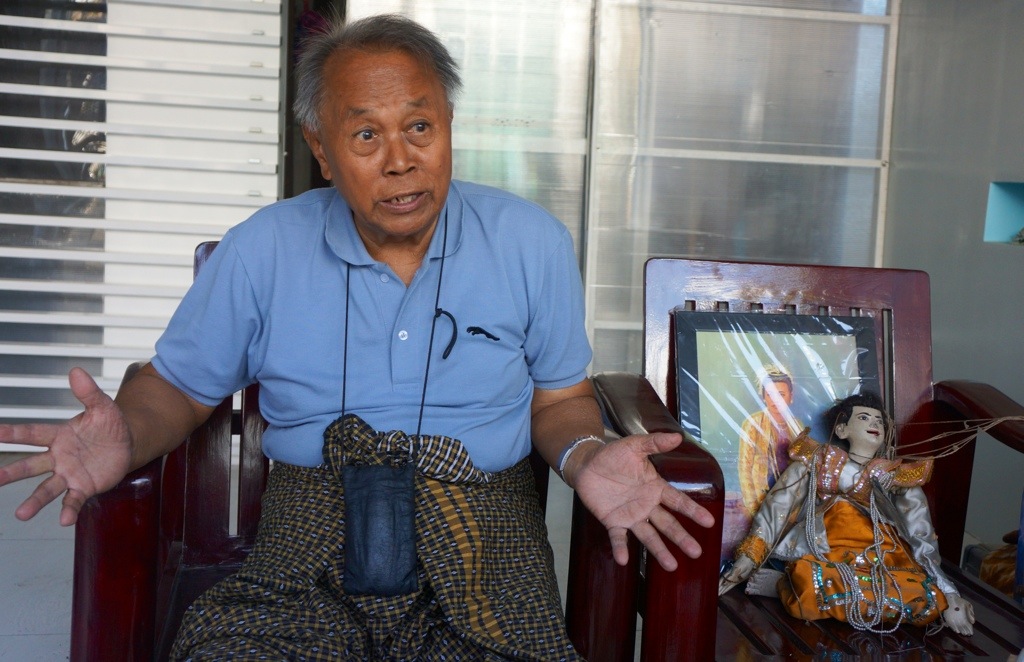
Lunched with Aung Lin Htet, then back to the hotel to rest and blog. Picked up at 4PM and drove to Shwenandaw Monastery, which is made entirely out of teak wood with beautiful intricate carvings. It was originally part of the royal palace built by King Mindon and moved to its current location by his son, King Thibaw in the late 19th century. It is the only major building from the original wooden royal palace to have survived the bombing during World War II, and thus is the only authentic part of the royal palace which can still be seen today.
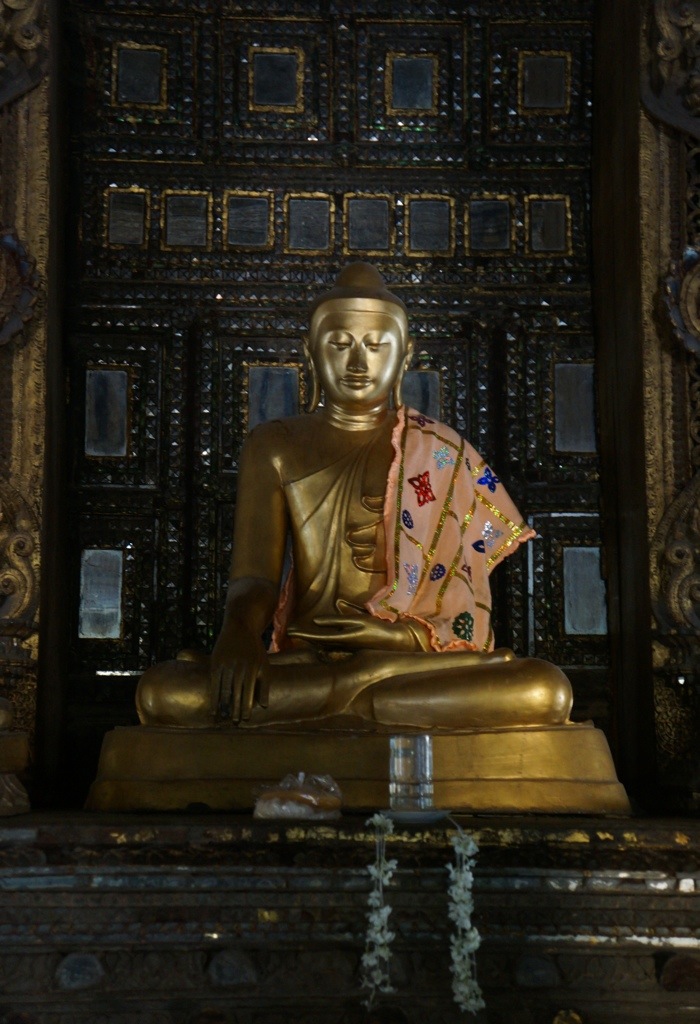
We drove by, but did not stop at, the Kuthodaw Paya, site of the world’s largest book. Located at the foot of Mandalay Hill and built by King Mingdon in the 1800s, 729 white stupas within the complex contain the complete text of the Tripitaka, Theravada Buddhism’s most sacred text. We continued on to Mandalay Hill a 230-metre hill located near Mandalay. Along its path are several monasteries and temples. We enjoyed the view and a nice, but not spectacular, sunset over the Irawaddy River.
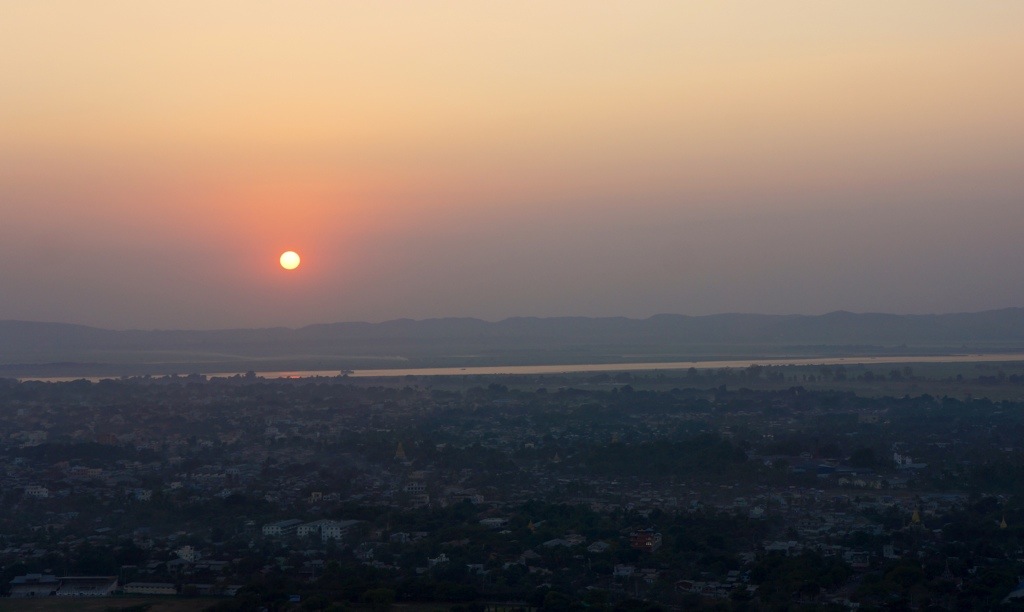
Waited in a long line for the small, slow elevator down, then continued on to dinner outside at a Chinese/Thai restaurant. There we met Aung Gyi and Daw Julie, Aung Lin Htet’s parents. He is an internist who will retire next month and continue writing essays and poetry. Daw Julie worked as a nurse before her three daughters and son were born. Their youngest daughter is a PCP grad, currently studying in New Hampshire, and the second daughter, who joined us at dinner, will begin a 3-month course to study for medical exams in Melbourne in May. Aung Gyi is Buddhist and Daw Julie, Christian. Each wanted Aung Lin Htet to be raised in their religion; he opted, in his general non-conformist and critical way, to follow neither.
Aung Gyi drove us back the short distance to our hotel, where Carol and I went up to the roof for a beer and nuts, and a traditional puppet show, before retiring.
January 19
Up at 4:15 for 5 AM ride to airport for 6:30 flight to Mandalay. Quick breakfast at hotel.
Easy ride to airport, where the domestic terminal looks right out of the 50’s. Security and baggage check are handled very efficiently. We board the Yangon Airways prop plane, which bears an insignia of an elephant with wings on its tail, raising the suggestion in our minds that this baby may take off only when elephants can fly.
Today’s quiz question, answer at end of this post. Who wrote:
By the old Moulmein Pagoda, lookin’ lazy at the sea,
There’s a Burma girl a-settin’, and I know she thinks o’ me;
For the wind is in the palm-trees, and the Temple-bells they say:
“Come you back, you British soldier; come you back to Mandalay!”
Come you back to Mandalay,
Where the old Flotilla lay:
Can’t you ‘ear their paddles chunkin’ from Rangoon to Mandalay?
On the road to Mandalay,
Where the flyin’ fishes play,
An’ the dawn comes up like thunder outer China
‘crost the Bay!
Apparently, elephants do fly. And offer advertisements on their overhead bins, outdoing us in commercialism.
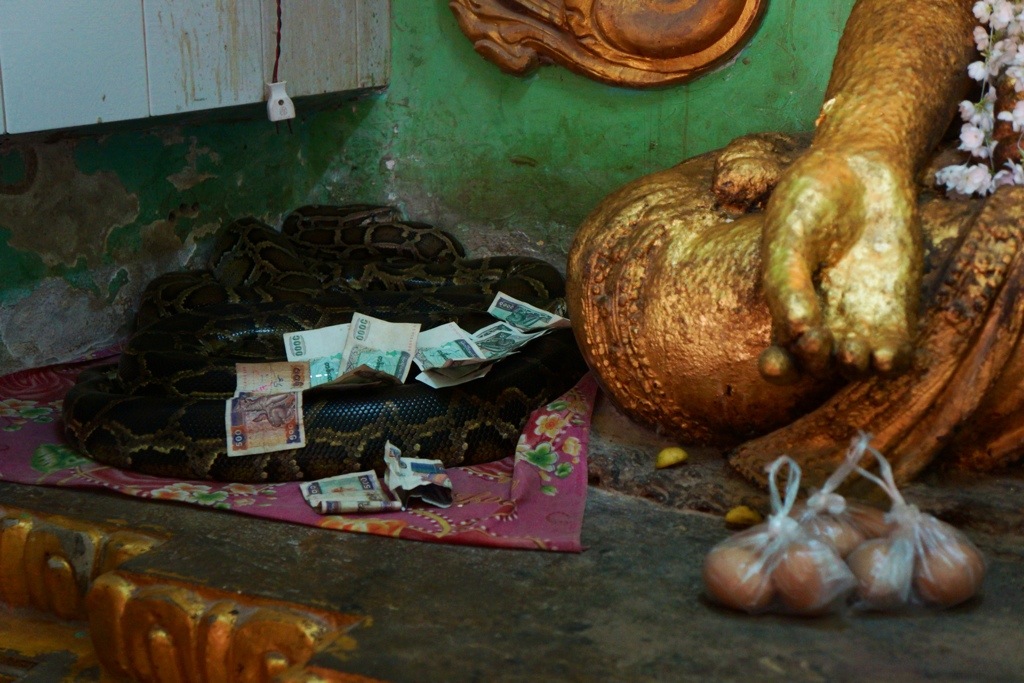
We drive to our hotel, The Arawady River View, but, as our room is not ready, we proceed to the home of U Khin Maung Sway, retired psychology professor and his wife, Daw Khin Marlar, a retired philosophy professor. There we have a most interesting couple hour talk, over tea and cake served by Daw Khin Marlar.
U Khin Maung Sway was sent to Russia in the sixties by the government and there learned Russian and socialism. Returning, he taught for 26 years in Yangon and Mandalay, before quitting. He sits across from us and speaks very slowly and deliberately. She sits off to the side, on a small stool, barefoot obviously listening, but saying nothing. (We learned on our first day that one takes shoes and socks off in homes and religious places, so I now wear sandals rather than lace walking shoes with socks.)
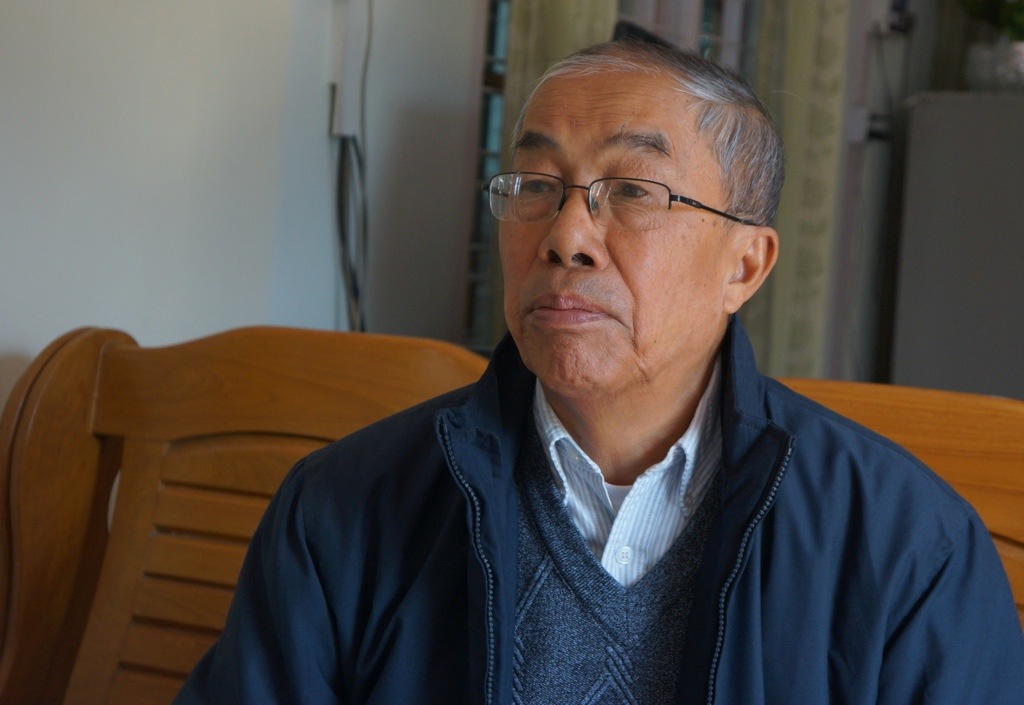
U Khin Maung Sway has written several books, which he shows us proudly, including the first of what will be two volumes of a biography of Freud and a book on neuropsychology. He has translated books from both Russian and English into Burmese. Before we leave, he gives us and signs about a 25-page English summary of a book on Bagan that he translated first to Russian and then, in this excerpt, to English. He clearly is pleased and proud to give it to us.
From our discussions with U Khin Maung Sway, it’s clear that teaching psychology in Myanmar is a tough gig, certainly not a growth industry. The enrollment in psychology is low, and decreasing. Educational content is governed by the ministry of education, who have no interest in psychology, other than the psychology of warfare, which he taught at one point. Psychological therapy is counter to Burmese culture and beliefs in astrology, shamans and the efficacy of nats (spirits).
When we drew Daw Khin Marlar into the discussion, she was animated and articulate, and much more fluent than her husband. She spoke at length about how the Burmese were not “educated,” able to think for themselves. Until this happens, the country cannot move forward. They both seemed to acknowledge that recent changes are positive, but have no illusions about any quick or short-term change. It will take a long, long time, “but we have to be positive, hopeful.”
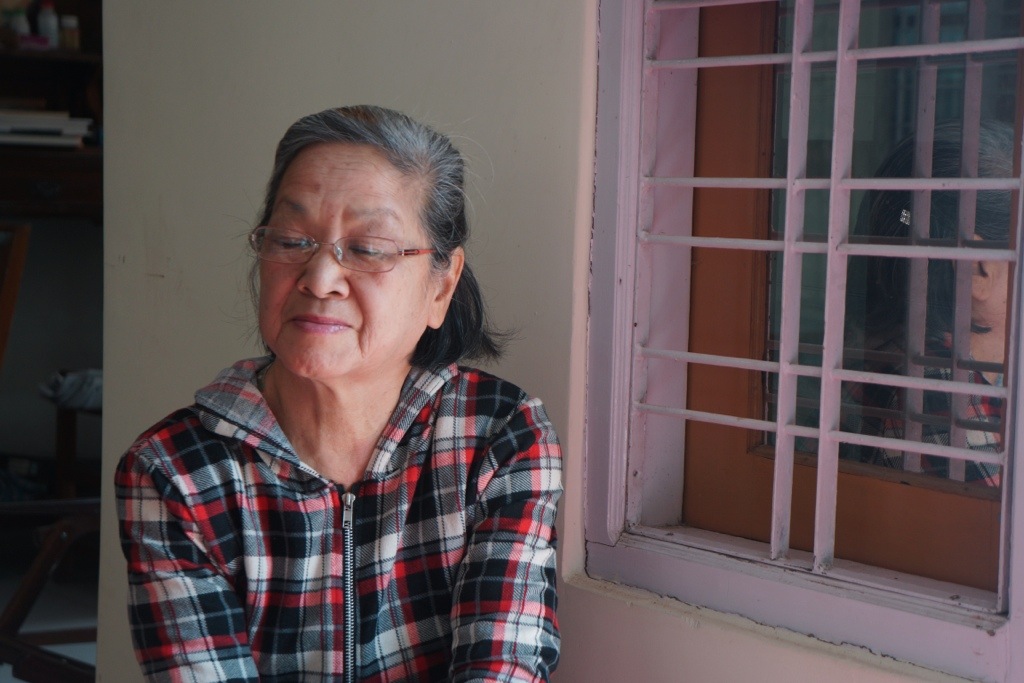
Lunch with Aung Lin Htet at a popular restaurant, frequented by a couple large tour groups. Carol and I feel very fortunate to be able to travel alone, with complete flexibility and control. We are joined at lunch by Naing Naing (he introduces himself as “Nie,” a relief to us, who have great difficulty with the Burmese names), a rather recent graduate of PCP, who studied for two years at a Japanese school. Nie works for the NLD, the National League for Democracy, Aung San Suu Kyi’s party. He has set up the two meetings we will have later in the day, and will accompany us in two days to visit the rural area from which he comes. While his English is quite good, his accent and speech pattern make him somewhat difficult for Carol and me to understand, so we are happy to have Aung Lin Htet to “translate,”
After lunch, we take a brief walk along the moat, two miles square, that separates what used to be the king’s palace in the 19th century. We then go to check into the Irrawady River View Hotel, at which our room has no river view. The hotel is passable, but a very far cry from the lovely Governor’s Residence.
We drive to the headquarters of the NLD, where pictures of Aung San Suu Kyi are everywhere and are for sale in the entry office.
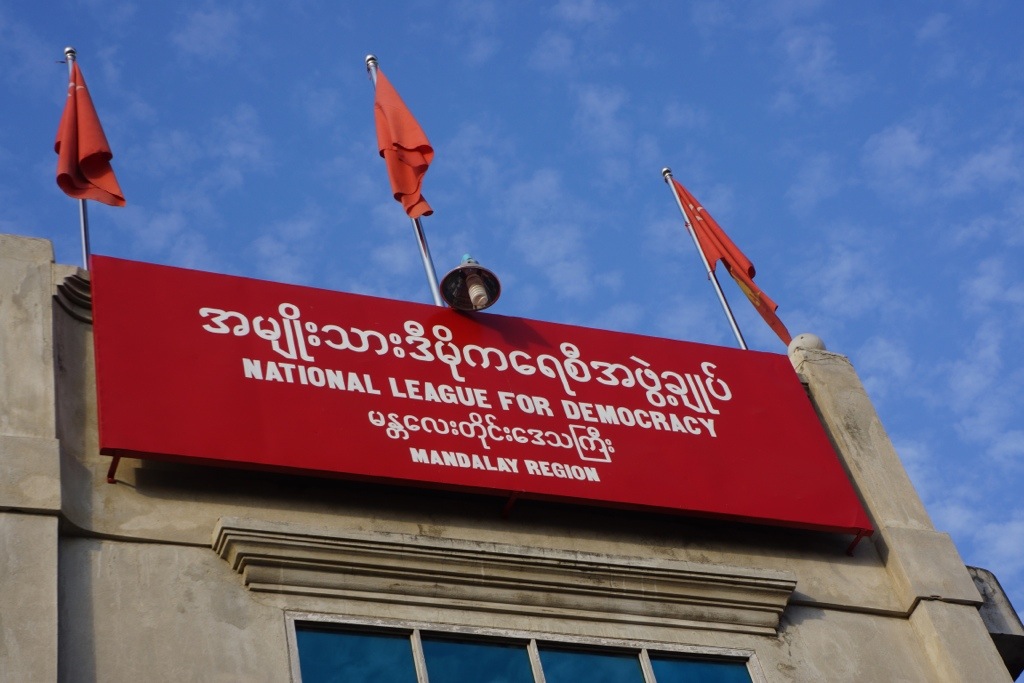
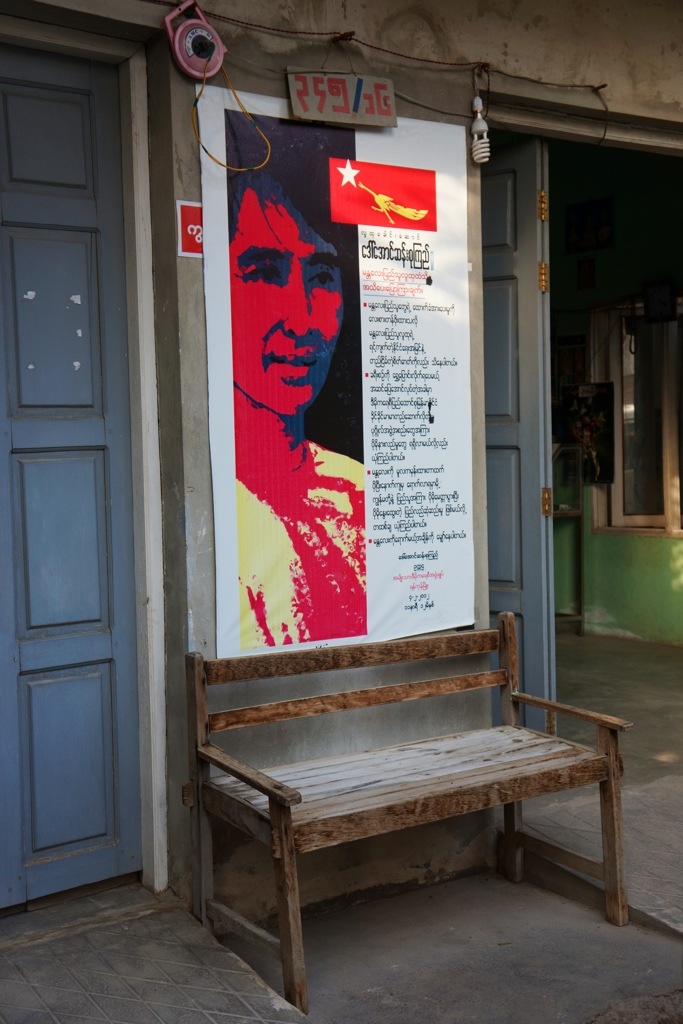
Upstairs, we meet for an hour and a half with the chairman of the NLD in the Mandalay Dvision, Daw Win Mya Mya, and U Hla Kaung, an executive committee member of the Mandalay Division of the NLD. Daw Win Mya Mya responds to the many questions that we pepper her with. She is very animated and fluent in her long responses, providing a translation problem for Aung Lin Htet, which he handles commendably.
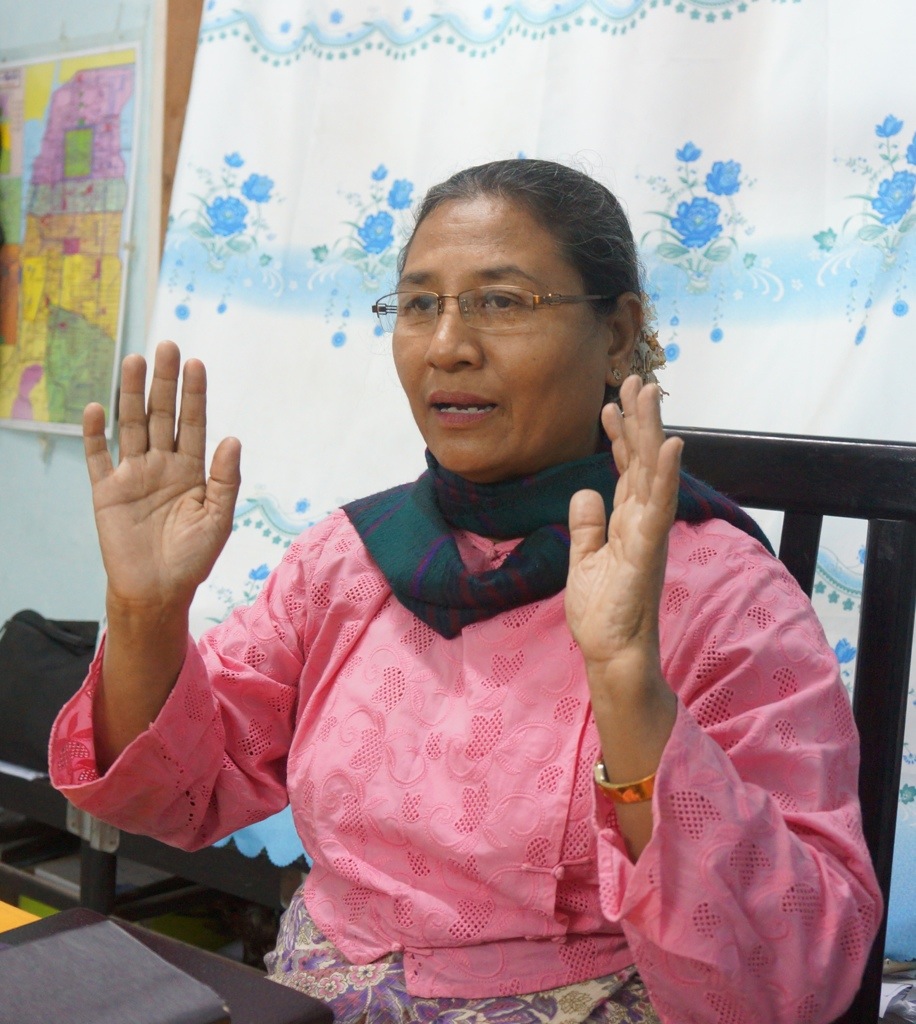
Three things emerge quite clearly from all of this discussion. First, the overwhelming priority issue is resolution of issues with Myanmar’s ethnic groups, who comprise over 40% of the population. Until that is done, nothing can be accomplished. Particularly acute is the armed conflict in the Northern Myanmar Kachin area. Second. Aung San Suu Kyi is viewed as an almost mythical figure; they are convinced that if she were given authority, all difficulties could be resolved with ethnic people who trust and revere her. Third, the elections in 2015 will be key, and afford an opportunity for real change to occur, if the NLD can gain control, rather than the 10% representation they currently have. (Nie expects to be a candidate in that election.) Once elected, necessary changes in the constitution, which still guarantees the military 25% of the legislative seats, and other reforms can be implemented. The meeting was unusual and informative.
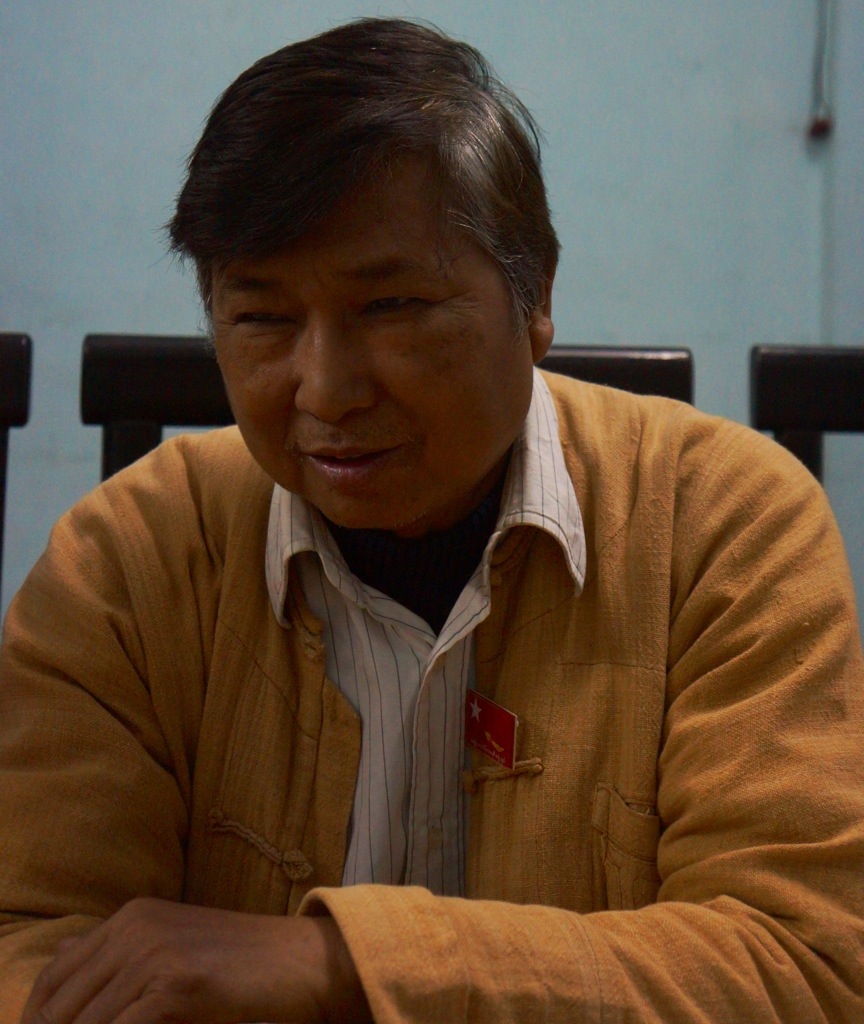
We drive to a small restaurant/coffee shop, where we meet upstairs for almost two hours with five former political prisoners, all of whom are now actively involved in environmental matters. All of them are in their forties and were student activists, part of the generation of ’88, that rebelled against the repressive , military government and paid a heavy price in torture, imprisonment and, for some, death. We learned about how false charges were manufactured against them by a paranoid government that thought that the students had more power or plans than they in fact had. Torture, then imprisonment under harsh conditions–relieved somewhat during periods that the Red Cross was there–and eventual release when the general who spearheaded all of this finally was brought into disrepute.
All of them are also involved with the new generation of student activists. When I suggested that students must respect and look up to them because of what they did, they said simply, “many others gave their lives.” They are remarkably unbitter, focused instead on the future. They are concerned about the psychological state of some of their friends and asked Carol for advice on how to deal with it.
The three principal environmental interests they had focused on all involved actions by China, the construction of a large dam on the Irrawady, destructive copper mining and an oil pipeline. The interests of countries like the US and Japan in controlling China’s influence are potentially useful in building support for the group’s efforts. Thus far, there seems to be only very limited international coordination of efforts.
They ask us about ourselves, and in the process, we discover that one of their group, Maung Tin Thit, is a poet. He is the one that both Carol and I took an immediate liking to because of his, kind and gentle manner of speaking. They all have very limited English, so Nie and Aung Lin Htet translate for us. The former prisoners offer to set up more meetings for us, but our schedule does not permit that. We exchange goodbyes and tell them it has been an honor and privilege to meet with them.
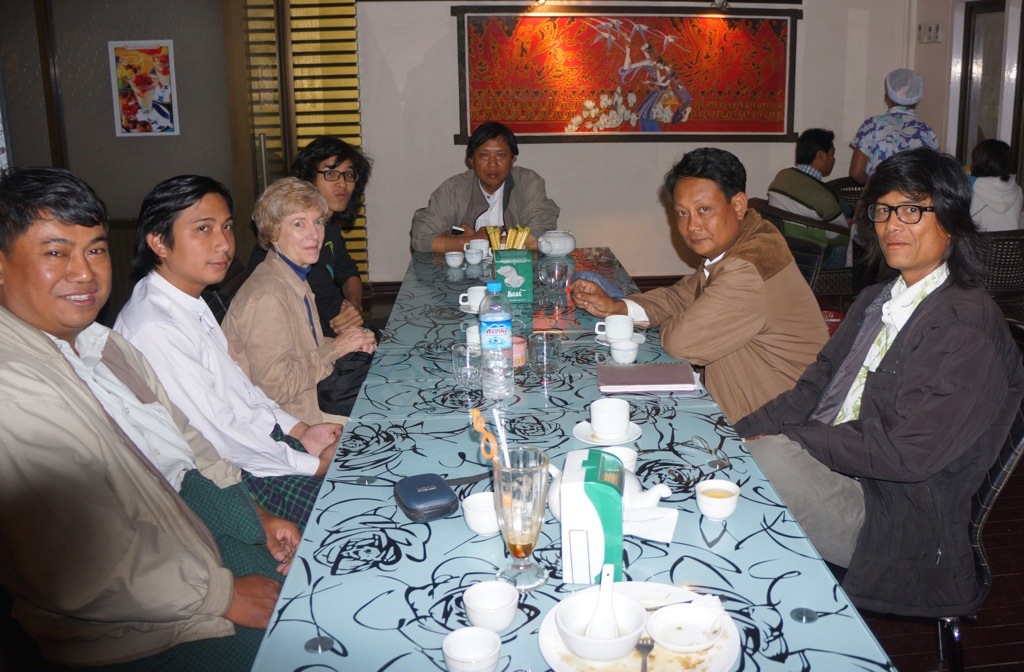
Carol and I go with Aung Lin Htet to a very good Indian dinner at a restaurant that Joe Feldman has recommended at the Hotel on the Red Canal. From there, we go to what was suppose to be a puppet show, but appeared to be a comedy show by the Moustache Brothers, at least one of whom was imprisoned by the military for his comedy. While it’s perhaps harsh to say so, we think his comedy is so bad that he should have been kept incarcerated. After 20 minutes, the three of us get out of our front row seats and leave. The house is packed and everybody else seems to think that the Brothers are hilarious.
We walk around the carnival-like street scene for a short time, then are picked up by a friend of Aung Lin Htet and driven back to our hotel, where we shower and retire immediately.
Answer to quiz question: quoted is the first verse of Mandalay, written by Rudyard Kipling in March or April 1890, at the height of the colonial period, when the British poet was 24 years old.
|
|























































